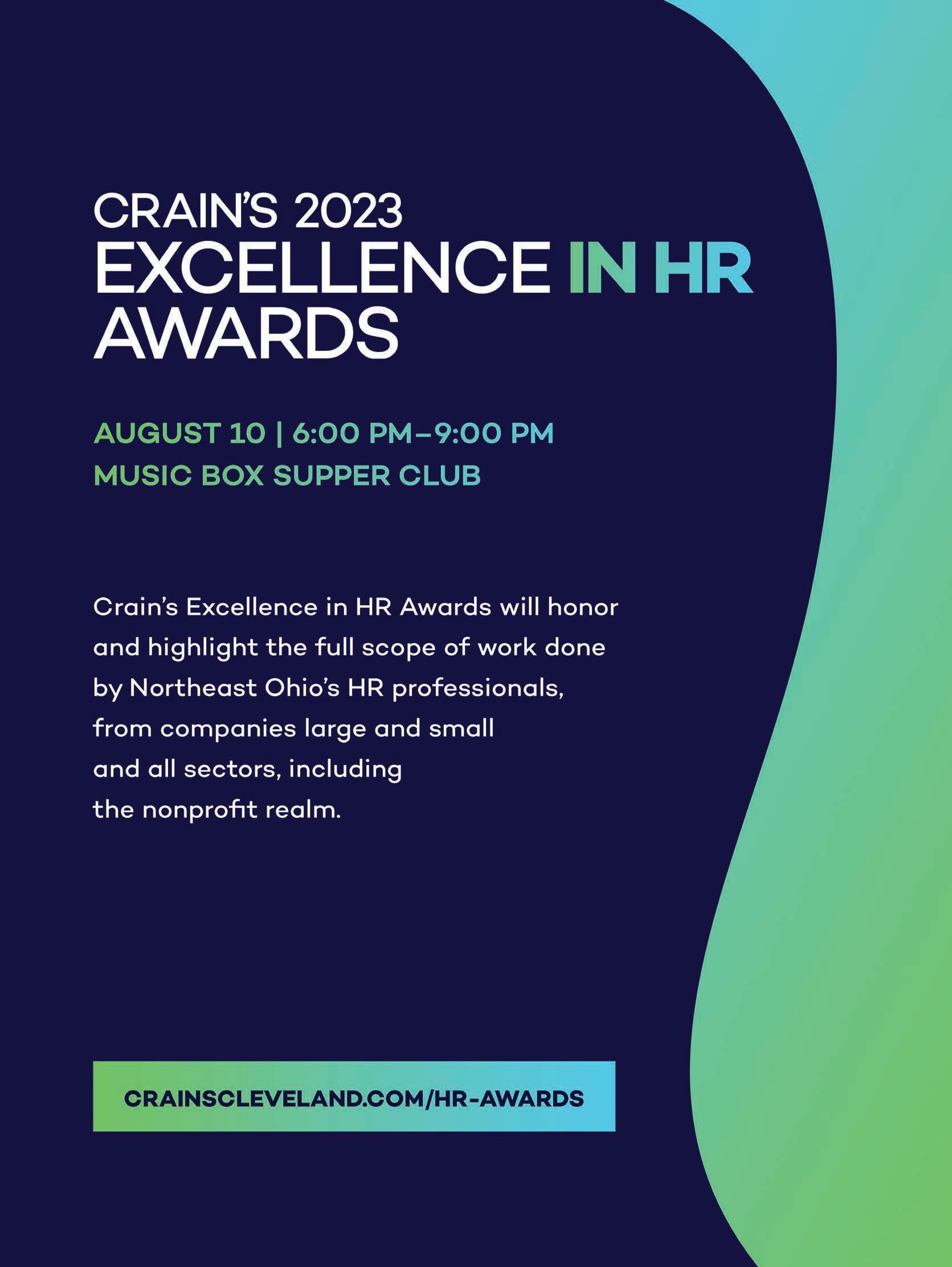Cuyahoga County is ahead of other municipalities in spending millions of settlement money. The opioid epidemic still persists, and those on its front lines are focused on nding the best sustainable uses of the nite funding. PAGE 11
Construction costs are cooling
BY STAN BULLARDAfter the tumult that has roiled the building business the past three years, Jason Jones, the Cleveland regional vice president of Turner Construction Co., sees a calming in the market.

“It’s nowhere near as crazy as it has been. We’re adapting to a new normal,” he said.


Prices “have not gone down, but the market has adjusted,” Jones added. “Concern has shifted from lead times for materials to the amount of labor on the site, especially among specialty contractors, such as steel erectors, concrete contractors, plumbers and electricians. Specialty contractors generally are so busy getting multiple bids it has been challenging. at’s what drives the pricing everyone is looking for.”
See CONSTRUCTION on Page 20
GCP nearly doubles development map
Midtown, University Circle added to interactive tool
BY MICHELLE JARBOEe Greater Cleveland Partnership, which rolled out an interactive map of development in downtown Cleveland last year, is expanding that resource in hopes of showcasing momentum in Midtown, University Circle and portions of the surrounding neighborhoods.

e chamber of commerce is nearly doubling the geographic footprint of the tool, which displays recently nished projects, active construction sites and signi cant plans. e scaled-up version, launched ursday, July 13, adds 4 square miles and 169 existing buildings or proposals.
e new territory mirrors the HealthTech Corridor, a barbell-shaped district that follows Euclid Avenue east
from downtown to University Circle, stretching a few blocks north and south along the way. e western end of the barbell is the Campus District and Asiatown. e eastern end encompasses the city’s educational, medical and arts district , along with parts of Glenville, Fairfax and Little Italy.
e idea is to help developers and investors get a bird’s-eye view of activity — and a fuller sense of potential opportunities.
“When you’re considering a development project … it’s really good to have a sense of what’s going on around you,” said Baiju Shah, the partnership’s president and CEO. “We think there’s a lot of merit in bringing disparate sources of information together.”
See MAP on Page 20
However, higher prices for materials are here to stay
New Fahrenheit brings the heat to 55 Public Square
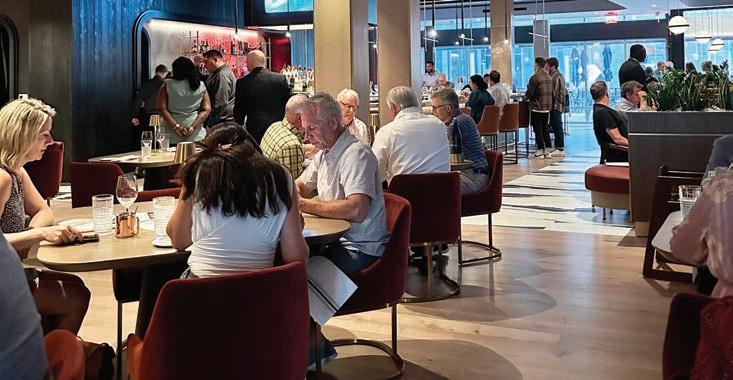

 BEV SHAFFER
BEV SHAFFER
Chef Rocco Whalen has always loved the idea and vitality of cooking, the crafting of dishes using local and regional ingredients, and the day-today enrichment of it all.


Perhaps all those distinctions in synergy with this quote from Ray Bradbury’s novel “Fahrenheit 451” were the impetus for Fahrenheit’s move from Tremont to 55 Public Square in downtown Cleveland: “… change something from the way it was before you touched it into something that’s like you after you take your hands away.
e di erence between the man who just cuts lawns and a real gardener is in the touching.”
Oh, what a move it is. e vibe is dressy and glittery, casual and cool — and very electric.
ere’s a chef’s table that embraces and welcomes 12, at the ready for hosting your personal celebration or a wine tasting and two luxurious bar areas that envelope full service bars reminding you that, yes, this is THE place you want to be.
e new Fahrenheit is a two-story culinary wonderland, with a menu featuring what Whalen calls “contemporary American regional cuisine” with Mediterranean and Asian accents, seafood not-to-be missed, and carefully crafted cocktails. Mediterranean and Asian in uences are woven throughout the selections.
Kick o the evening with a crafted
summer cocktail, Tequila Mockingbird with jalapeno rosemary infused tequila. Tempt your taste buds with an Umami Ravioli then refresh with Lexi’s Apple Salad. For your entrée, it may be di cult to decide between Fahrenheit’s signature Wagyu Short Ribs or the Kalbi Lamb Chops. Order both and share tastes. Tokyo “Street” Corn and Roasted Tru e Wild Mushrooms are two of several signature sides that complement the meal.
Since a night out at Fahrenheit should always have that wow factor, desserts are a must. e Brown Sugar Japanese Milk Bread (think sophisticated Asian twist on bread pudding) and the Cotton Candy Tree with Tru es will delight the kid-with-asweet-tooth in all of us.

Once you’ve enjoyed all that dinner has to o er, take the sweeping staircase to the top and elevate your evening with a selection or two from the exclusive rooftop menu. It’s the perfect spot to take in the sights of downtown Cleveland.
Fahrenheit at 55 Public Square opened at 4 p.m. Friday, July 14. Reservations are highly recommended. Enjoy the tastes and ambiance that is the new Fahrenheit. As Ray Bradbury would say, “Stu your eyes with wonder.”
Sha er is a freelance reporter for Crain’s Cleveland Business. Her focus is on the restaurant scene, as well as food and restaurant trends. She can be reached at bev.foodwithattitude@ gmail.com.
Are we still stirring the cooking pot?
BEV SHAFFERIn most kitchens mid-pandemic, our was ying and dough was rising. We were creating breakfasts, snacks, homemade breads and dinners from recipes discovered in dusted-o cookbooks and from watching how-to videos.
One part boredom, one part trying to save money, and one part wanting to copy recipes previously enjoyed at favorite restaurants, it was a (somewhat) brave new and often delicious world.
Although most are back to work in a hybrid situation, are home cooks still stirring that pot and continuing on that journey of improving their cooking skills? Was the lockdown indeed a springboard for a new set of up-and-coming master chefs, or did cooking fatigue create a need for cooking breaks?
“Many of my clients thought the pandemic would last much longer, so they began canning, fermenting and preserving food items just in case,” said chef Eric Wells at Skye LaRae’s Culinary Services.

Charlie Denk, owner at Stir Studio Kitchen, said, “ e lockdown was a springboard for a lot of changes in peoples’ lives. Cooking is not an exception to that.”
He continued, “I do think the appreciation of coming together over food is as strong as ever. People are inspired by dinner parties they see
on social media or trends revolving around new innovations like athome smokers, pizza ovens, sous-vide machines. e use of that technology is no longer limited to restaurants or professionals.”
Loretta Paganini, director of the Loretta Paganini School of Cooking and the International Culinary Arts and Sciences Institute (ICASI), agreed.
“Many of the people returning to our classes are doing so to continue developing interests discovered or strengthened during the COVID-19 shutdown,” she said. “Bread-making is big, but so are pasta-making, sauce-making and an exploration of our various ethnic traditions. In addition to learning new skills during the shutdown, many people also discovered areas they could improve on — knife skills is a very common interest, but the desire to improve basic skills in general also drives much of our registration.”
At Sur La Table, simple, tasty and easy are what people are looking for when they attend classes.
Kelly Arnold, Sur La Table’s training chef/mentor, said that participants “are looking for new ideas to incorporate into their everyday routines.” Not a lot of mess, not a lot of fuss but “not menus that are overly complicated. ey are back to having short periods of time to get dinner on the table while working within a budget.”
Both Denk and Paganini shared
thoughts on restaurants versus home food preparation, post-pandemic.
Denk said, “I feel people are more inclined to cook at home these days primarily because it’s just become increasingly di cult to have a compelling meal and experience in a restaurant. For so many reasons (most of which were brought on by the pandemic) the quality of food and service to be found in restaurants has declined while prices have increased. It’s just harder to justify the spending.”
Paganini added, “Since we entered the pandemic, much has changed in the world of food, especially in our restaurants. As prices rise, it seems that many are turning to preparing their own food as a self-satisfying experience, but also as a means of entertainment.”
And those up-and-coming master chefs? In ICASI’s professional program, many students found their true passion and interest in cooking during the pandemic. e need to be at home created a newfound comfort in cooking combined with the realization that they could turn that newly realized passion into a career, whether it be traditional restaurant employment or a potential small-scale business which would allow future chefs to work alone or with a few colleagues in a less stressful environment.
For all the schools, every day cooking fatigue and the need for a cooking break sells classes.
At Skye LaRae’s, Wells consistently sells out classes to eager groups looking for fun and entertaining ways to dine while meeting new people. e same is true at Stir Studio Kitchen, where most are coming into their studios not to learn a new technique but just to have a unique and special experience. At ICASI, people are gravitating toward cooking with friends and family as a more common pastime, and in their multi-part series classes, students are forming
close friendships around their mutual interest of food and cooking. Let’s keep that pot and spoon for stirring handy. As Julia Child would remind us, “I was 32 when I started cooking; up until then, I just ate.”
Sha er is a freelance reporter for Crain’s Cleveland Business. Her focus is on the restaurant scene, as well as food and restaurant trends. She can be reached at bev.foodwithattitude@ gmail.com.
Relationship with city a growing strength for UA, president says
BY RACHEL ABBEY MCCAFFERTY
When Gary L. Miller took on the role of president of the University of Akron in the fall of 2019, he was the fourth leader in about ve years.
Today, he’s looking forward to his fth year as the institution’s leader, working to strengthen the university and the city that houses it.
One of Miller’s top goals has been growing the university’s relationship with the city of Akron and the local public schools.
e university is a large employer in the city, Miller said, and its academic programs support the businesses and health care institutions that surround it. It houses two high schools on its property. And Miller highlighted the planned renovation of the Polsky Building, supported by a $20 million Knight Foundation gift, as a way to further strengthen the university’s presence downtown.
“What I tell our students here is that you, within 2 miles of the center of this campus, you have every American challenge and every American opportunity. We’ve got poverty. We’ve got income disparity. We have things you need to know about and learn how to serve. And we, as an institution, need to be part of the solution,” Miller said. “ at’s part of our DNA here, is the city of Akron.”
Akron Mayor Dan Horrigan in an email said the city’s “success is tied hand in hand” with the university’s.
“Our ability to work collaboratively to support each other is vital to our potential to thrive. Having a pipeline of talent from the university that we can recruit and retain here in our community is so important to Akron’s growth and we’re proud to have a strong partner in UofA,” Horrigan continued.
Greater Akron Chamber president and CEO Steve Millard shared a similar perspective via email.






“In a city like Akron, the success of the University of Akron is tantamount to the success of the city. And, similarly, the University can’t succeed without the active support


and collaboration with the city,” Millard wrote. “UA is attracting thousands of young people and giving them a connection to the City of Akron. We need to keep those students far past graduation and engage them with our companies large and small to have careers and families here.”
While Miller has been president, the university has “embraced” the city and worked with the business, arts and civic communities overall, Millard said.
“My sense is that Dr. Miller has provided clear direction to his team at UA that they will be present, connected and impactful with the initiatives that are critical to our community and, as such, UA itself,” he added.
pandemic. ere were layo s. e university has signi cant debt, which it is working to pay down through initiatives like a recently announced plan to privatize parking.
And enrollment has yet to increase, though Miller said he sees signs that it’s stabilizing.
Numbers aren’t yet available for fall of 2023, but enrollment has been falling in recent years, a trend that predates the pandemic. University data shows that, in fall of 2017, there were 22,104 students at the University of Akron. In fall of 2021, there were 16,193; last fall, there were 14,991.
—Gary L. Miller, University of Akron president

Miller highlighted the inclusion of innovation hubs in the state budget as a recent collaborative win on behalf of the university and business partners in the community.

Miller said Akron’s “push” was around its polymer science program. Budget allocations haven’t been made just yet, but Miller is optimistic Akron’s portion will be signi cant.
Miller has overseen more than just community investments, however; improvements have been made in the heart of the campus, too, to athletic facilities and academic buildings. e university has gotten rid of some real estate, Miller said, and entered into a partnership with the city and the county to improve security south of Exchange Street, implementing a camera project in areas where students often live.
ere have also been clear challenges in recent years. ere was a








ere have been pockets of growth; Miller said interest is growing in the university’s long-popular international programs, and its honors program has seen record enrollment in recent years. And retention is a critical component, too. Akron is an “opportunity university,” Miller said, and that means it needs to provide support to students who need it.
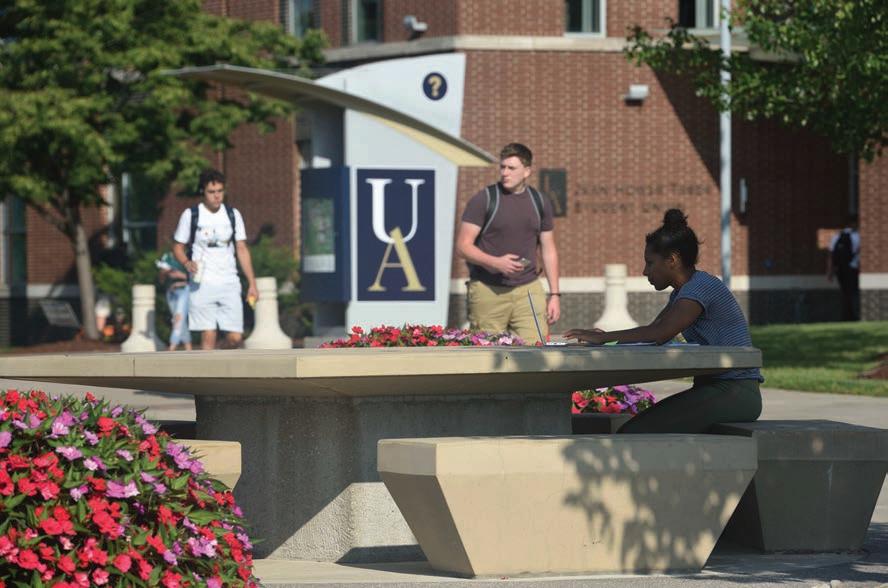
The university’s people are one of its strengths, Miller said. As an example, Miller noted that educators and staff were able to come together during the pandemic to get classes online within weeks. They take care of the students, he said.
“ e reason I wasn’t intimidated by the position in the rst place is that I had a little bit of experience with Akron before in my professional career, but I could also tell from the outside that the people here were just outstanding, that the faculty and the sta , even in some very di cult times, were still being really creative, really, in large part, constructive,” Miller said. “ ey were sticking with the place. ey were committed to it. And I found that to be the case.”
Rachel Abbey McCa erty: (216) 7715379, rmcca erty@crain.com


“WHAT I TELL OUR STUDENTS HERE IS THAT YOU, WITHIN 2 MILES OF THE CENTER OF THIS CAMPUS, YOU HAVE EVERY AMERICAN CHALLENGE AND EVERY AMERICAN OPPORTUNITY.”
Howard Hanna listing change launches cyber-turf dispute
BY STAN BULLARDHoward Hanna Real Estate Services has barred competitors from directly posting its listings on their company websites.
It did so the rst week of July by dropping its online feeds to what is called the Internet Data Exchange, or IDX, which allows other residential brokerages to use Howard Hanna’s listings to help populate their websites. Howard Hanna continues to put competitors’ listings on its site.
Although competitors fume, Howard “Hoby” Hanna IV, the Cleveland-based president of Howard Hanna and related companies headquartered in Pittsburgh, noted house hunters still can see all market listings shared on MLS Now, the Valley View-based Multiple Listing Service operated by the region’s real estate boards, and on Zillow, Homes. com and Realtor.com.
Mike Zinicola, a co-founder of the Keller Williams EZ Sales Team in Westlake, said the move is a break from the widespread sharing of information that is a central tenet among brokers who may bring buyers to a competitor’s property listing.
“ e real estate industry is di erent than any other,” Zinicola said in a phone interview. “If you don’t see something you like at a BMW dealership, the salesperson does not drive you to a Mercedes-Benz dealership.
In our industry, we work with each other to succeed.”
Zinicola acknowledges the move reduces how many listings a rm such as his may have available to put on its website, and he argues it may back re for Howard Hanna.
“As a listing agent, you want to market your client’s home on every available means,” Zinicola said. “If I were with Howard Hanna, I wouldn’t want to explain to a (sales) listing prospect that a listing would not be on a competitor’s website.”
e move by Howard Hanna has given his rm another way to win listing assignments and may cost Howard Hanna agents, Zinicola said.

Jose Medina, operating partner of Keller Williams Elevate in Strongsville, Keller Williams Living in Solon and Keller Williams Legacy in Canton, said he considers Howard Hanna’s decision “a bold move. I don’t think that this decision is best for their clients. If they are taking their listings o of competitor’s websites, that will hurt their business in my opinion. When someone from Chicago looks for a house in Ohio, they look on the national websites. ey (typically) don’t know the regional brokerages.” Likewise, Inna Muravin, the broker for Engle Völkers in Northeast Ohio, said the move will not hurt her rm’s business.
“It will hurt their business as they may lose agents,” Muravin said. “In the web world, we want to advertise our listings everywhere. at doesn’t sound like what the real estate community has been about.”
Ironically, consumers will still be able to nd all the listings from MLS Now on Realtor.com, Homes.com and Zillow. ose services will get Howard Hanna home sales listings from MLS Now under a di erent feed, called Virtual O ce Website, or VOW.
For Howard Hanna’s part, Hoby Hanna said the IDX was set up in the infancy of residential real estate going online, and his company wants to test a di erent approach.
“When I put a Howard Hanna sign on a property, my competitor can’t put it next to mine,” Hanna said of allowing other brokers to post its sales listings, with attribution, on their sites. “For years I’ve said to myself that this IDX policy makes no sense. We’ve had people show up at open houses with a Realtor and ask the listing broker, ‘Who are you?’ “
Moreover, Hanna said lists provided through the MLS VOW system provides more detail for consumers, such as when a house has an expired listing and changes in price.
“Most consumers do not believe brokers share all the information online,” Hanna said. “ is will make it more transparent.”
e switch to keeping its listings
from competitor websites also will not change the most fundamental aspect of the brokerage business: Companies will still split commissions.
Hanna also said the online listings for his company are accompanied by other marketing e orts, from postcards to TV shows, which produce bene ts for its listing clients, as well as multiple e orts to ensure its listings are available and widely seen. e decision also does not change the MLS, Hanna added, as it is primarily a business-to-business (or broker-to-broker) portal.
Carl DeMusz, CEO of MLS Now, said the posture of the MLS is to forward members’ listings to wherever a member wants them to go.
“It’s like we’re in Geneva,” he said. “We provide the information. We don’t govern their business model. We want them all to succeed.”
So, what will competing brokers do if they cannot put Howard Hanna listings on their company sites?
“We’ll set them up to see listings from the MLS,” Zinicola said.
Hanna said Howard Hanna will test the change until the end of October. If it produces the bene ts it expects, the company will extend the practice to other MLS operations in the areas where it operates, Hanna said.
Stan Bullard: sbullard@crain.com, (216) 771-5228, @CrainRltywriter
It’s time to apply for the Weatherhead 100
The Weatherhead 100, Northeast Ohio’s premier celebration of entrepreneurship, is now accepting applications.
For 35 years, Weatherhead School of Management at Case Western Reserve University has recognized an elite group of companies who serve as the best examples of leadership, growth and success in our region.

This year, the Weatherhead 100 welcomes a new category honoring Emergent Business and renames two others to better depict the region and the companies being honored— Titans replaces Centurion, and WH100 Enterprise is the new name for the former Upstart category.
To apply for the Weatherhead 100, or learn more about the awards, visit case.edu/weatherhead/100 by July 31.

EDITORIAL
Setting the stage
These are di cult times for the performing arts, with institutions nationwide cutting back schedules and reducing sta , the result of what e Washington Post called a “perfect storm of bad economic and demographic trends, exacerbated by a change in cultural habits during the pandemic” and diminished commitments from funders.
We’re rooting for arts institutions everywhere, because they improve the quality of life and are strong generators of economic activity. e Ohio Legislature agreed and, in its just-passed budget, did the performing arts a solid.
Legislators approved changes to the state’s motion picture tax credit that raises the annual amount available to $50 million from $40 million, and, most critically, designates $5 million for theatrical productions. e changes are e ective for the 2023-24 scal year, which began July 1.
e $5 million set aside for theater will enable Cleveland’s Playhouse Square, as well as the Cincinnati Arts Association, the Columbus Association for the Performing Arts and Dayton Live, to be more competitive in attracting productions to Ohio, thus creating more employment opportunities and increased spending on activities associated with theatrical productions.
Tax credits are critical in this arena. Playhouse Square’s new CEO, Craig Hassall, said in an interview that three upcoming shows have shorter engagements here due to a lack of available tax credits that producers could nd elsewhere. In other cases, producers chose di erent markets for technical rehearsals.

“Each one was a dagger to my heart,” Hassall said.
e changes to Ohio’s tax-credit program will put Playhouse Square and the other institutions more rmly in competition for productions. Hassall said initial response from producers has been “e usive,” as Cleveland is a strong market due to its huge core of KeyBank Broadway Series subscribers and the city’s relative proximity to New York and ease of access to other tour markets.
e impact of changes likely won’t be seen until at least 2025, Hassall said, given the long lead times of planning for big productions, but the additional revenue generated for the state should far exceed the $5 million set aside in tax credits. More productions here would lead to more jobs for skilled trades workers and service employees, and more chances for people breaking into the industry in lighting, sound design,
costuming, set design and other related disciplines. In a challenged environment for the arts, this move by the state sets the stage for growth opportunities.
Safety rst
T he recent shooting of nine people in downtown Cleveland got more attention than most of these tragic (and unfortunately frequent) occurrences because of its location — the heart of the Warehouse District, one of the city’s liveliest areas.
e aftermath, though, is the same: Lives forever changed, concerns about safety ampli ed. No one died, thankfully, in this mass shooting, but it underscores the reality of life in 2023 in Cleveland and many other places: People don’t feel safe. We shouldn’t have to live like this.
Good police work (probably aided by the o er of a substantial monetary reward) led to the relatively quick arrest of a suspect in this case. As much of a relief as that is, it doesn’t change the concerns of residents — the Warehouse District is a place to live, as well as work and play — about violent crime and the way it a ects their lives. ose concerns play out in every neighborhood where these shootings occur.
e easy availability of guns is of course a huge problem that’s not going to be solved anytime soon on the state or national level. A big challenge in Cleveland is police recruitment, as the city’s police force remains about 200 o cers short of the budgeted number of nearly 1,500. City leaders and local law enforcement organizations have scheduled a safety summit for next month, and their focus should include strategies to maximize o cer retention, recruitment and deployment.
At the end of last week, tensions between Mayor Justin Bibb and City Council intensi ed, with the violence issue as the central (but not only) cause. Bibb, along with his directors and chiefs, skipped council’s July meeting after Safety Committee chair Mike Polensek issued a statement indicating he was going to use his personal comment period to discuss “out of control” violence.
Get over it. Cleveland, its residents and businesses owners need leaders to focus on making the city safer, not political dust-ups. People should be able to go about their daily lives without fear.
PERSONAL VIEW
Have you ever thought about what happens with your dollars when you make a deposit with your bank? Whether you’re a business owner or everyday consumer, this probably isn’t at the top of your mind when deciding which bank to put your trust in — especially amid the confusing nature of the currentnancial environment.
But ponder for a moment the implications of placing your cash with a bank.
In simple terms, when you make a deposit at a bank, this money is aggregated with other deposits and is reinvested into the community such as in the form of mortgages and small business loans.
Whereas larger banks serve multiple communities and/or countries, a community or regional bank typically reinvests deposits back into the local community. When you choose to place a deposit with your local bank, you’re directly putting your dollars to work in your own community by uplifting other small businesses, nonpro ts and individuals in your neighborhood.
e recent challenges facing the nancial industry are centered around a few large, nontraditional banks where fear, perception and lack of investment diversi cation contributed to their failure.
Banks are ranked by asset size, with the largest banks managing more than a trillion dollars in assets. e smallest banks manage less than $5 million in assets. As a point of comparison, West eld Bank manages over $2 billion in assets.
Unfortunately, recent news headlines don’t remind you about the stability, resiliency and positive local impact of the more than 4,700 community banks across the country — 73% of which have less than $500 million in total assets and, like West eld Bank, have successfully navigated multiple recessions, global con icts, pandemics and other periods of economic and geopolitical volatility.
Furthermore, 80% of commercial real estate in the U.S. is nanced by the smallest banks in the U.S., those with less than $250 million in assets. at’s a signi cant number of o ces, manufacturers, small business owners and more that are empowered by the local bankers down the street.
Concerns have grown around banks’ ability to insure deposits larger than the FDIC-protected $250,000, prompting many consumers and business owners with large deposits to turn to larger banks. is decision is often a result of the perception that large banks are a more stable option. In reality, however, some smaller banks like West eld Bank o er solutions that enable deposits well beyond $250,000 to be fully FDIC-insured.
ese days, it’s easy to nd yourself confused about the current banking and nancial environment. at’s why it’s worth remembering that smaller banks have been and will continue to be a vital part of an industry that has demonstrated resiliency, dependability and community commitment for centuries.
ere’s never been a more important time to put your trust in your local community bank. By choosing to bank local, you’re choosing the caring hands and expertise of working with your neighbors and friends who share a common interest in building a thriving community.
As the leader of one of Ohio’s top community banks, I’m proud to say that our nancial health, stability and commitment to our community strengthens our resolve to serve our clients during these times of confusion and volatility.
Executive Editor: Elizabeth McIntyre (emcintyre@crain.com)
Managing Editor: Scott Suttell (ssuttell@crain.com)

Contact Crain’s: 216-522-1383
Read Crain’s online:
MIKE TOTH
Community banking has never been more importantKEN BLAZE/PLAYHOUSE SQUARE BY MICHAEL WEIDOKAL

e rollout of ChatGPT and a host of other forms of arti cial intelligence has led to a dramatic increase in interest and awareness of arti cial intelligence. Despite the fact that these tools had been in development for many years, the capabilities of some of these AI tools have generated shock, awe and curiosity. For example, while it took Instagram 2½ months and Facebook 10 months to reach 1 million users, it took ChatGPT just ve days to reach this milestone. If the world wasn’t aware of arti cial intelligence beforehand, it sure is now.
Given the powerful and wide-ranging capabilities of arti cial intelligence, there is little doubt that AI will have a profound impact on most areas of our lives for the foreseeable future. e one area that I want to focus on in this article is arti cial intelligence’s impact on the economy. On one hand, AI has the capability to solve some of the long-term problems that are facing the global economy, as well as the economy of Northeast Ohio. On the other hand, AI also has the potential to be so disruptive as to sow chaos and destruction. How we manage AI will go a great way toward determining our long-term economic future.
For years, I have been arguing that the only path to long-term economic expansion and prosperity is through higher rates of productivity growth. With population growth slowing in our region and around the world, and with trade and investment levels that are much lower than in the past, our only means of generating higher rates of economic growth will be through higher levels of productivity growth. Unfortunately, productivity growth in most major economies has been trending downward for many decades now, and there seemed to be no end in sight to this decline.
However, the emergence of arti cial intelligence has raised hopes that productivity growth can be revived on the back of AI-based tools and processes. Some economists believe that arti cial intelligence can eliminate many of the bottlenecks currently constraining productivity and economic growth. If so, AI could prove to be a positive game-changer when it comes to generating economic growth in the future.
Another factor that has been hampering economic growth in our region and around the world is the fact that labor shortages continue to worsen for most sectors of the economy. Worse, recent demographic trends indicate that these labor shortages are not only here to stay, but that they will worsen dramatically in the future.

As such, this is another area in which arti cial intelligence could solve a pressing economic problem, for AI

could dramatically reduce the demand for labor in many economic sectors.




At the same time, like other new technologies in the past, arti cial intelligence could create many new jobs and occupations that have not existed in the past. For example, 60% of today’s workers are in occupations that did not exist in 1940. erefore, it is widely expected that AI will not only solve labor shortages in many sectors of the economy, but will also create a variety of new jobs that do not yet exist. Furthermore, these new jobs are likely to be much more productive than the jobs that will be replaced by various forms of arti cial intelligence.



Two sectors of the economy that are expected to realize signi cant improvements in productivity thanks to arti cial intelligence are manufacturing and health care. For Northeast Ohio, this presents a unique opportunity, as manufacturing and health care are the foundations of our region’s economy.



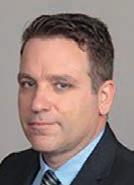
As labor shortages remain the leading constraint on growth for Northeast Ohio’s manufacturing and health care sectors, arti cial intelligence has the potential to mitigate the economic impact of our region’s demographic decline and allow these sectors to continue to ourish in our region. In fact, arti cial intelligence has the potential to completely transform Northeast Ohio’s economy for the better, possibly ushering in a new era of growth for a region that has fallen behind many of its peers in recent decades.

Many economists believe that arti cial intelligence has the potential to drive much higher rates of economic growth in the coming years. Other economists believe that any positive impact on the economy from arti cial intelligence will only be realized over the longer term. Furthermore, there are many experts who warn that the spread of arti cial intelligence could lead to widespread social and political unrest that could actually harm the economy rather than bene t it.
Regardless, there is little doubt that arti cial intelligence will transform many sectors of the global economy, including many of those here in Northeast Ohio. As such, it appears that we are on the cusp of a major economic revolution, much like the Industrial Revolution of the late 18th and early 19th centuries. is will transform our world, and our region — hopefully for the better.
Commercial real estate realities
















The new semi-normal in Northeast Ohio



It’s always a smart move in business to seek out expert guidance, but it’s particularly savvy to do so when you’re operating in a space facing uncertain conditions. A good example is the commercial real estate sector, which has been impacted by many factors recently – the pandemic, the rise of work-from-home culture and most recently, rising interest rates.
Let’s start with interest rates. Historically, the current rates are actually not bad. What is different and unsettling for many people is the pace at which they increased over the last year and a half.
The primary impact of the rise in rates has been the general lowering of the amount of debt a bank is willing to lend on an income-producing property. Banks need to see a cushion or cash ow above the loan payments. That’s what we call the debt-service coverage ratio. The total loan payments are the denominator and the numerator is the cash ow before the debt. In simpler terms, the more your payment goes up, that puts pressure on the ratio, which means the loan
amount any bank is going to be willing to provide is going to come down.
For example, if prior to the rise in interest rates you needed to contribute 20% equity to hit the right ratio for a certain project, for example, now you might need 25 or 30% equity. That’s not to say the project won’t get done by the developer, but the design or scope may need to be changed to make more economic sense.
This current environment impacts the number of projects that a bank or lender may see as viable for a single builder or developer. When possible, I like to help our clients – who may be working with more than one bank – do some forecasting. I might say, “for where you are at with active projects, you probably have one more of this size of project that banks will be interested in,” as an example.
Another thing to understand is that banks want
to have a diversi ed portfolio and not be concentrated in a certain asset class. Your project might be viable, but some banks might be full, for example, on multi-family projects. So, for that reason, they may decline. But, perhaps Farmers is not full on multi-family, so we look at the deal.
When offering my perspective on a potential opportunity, I will often say to someone, “I’m just one vote, here’s my voice” — I’m looking to present helpful ideas in your decision-making process. I try to provide guidance, not just a yes or no.
We are continuing to see new multi-family projects, albeit at a slower pace. And industrial real estate is still a strong asset class. A highceiling warehouse being built near an interchange, for example, still has some strength. Some of it is at the expense of retail, because when you buy something online, it’s generally stored in a warehouse and not in your local store.
The reshoring of manufacturing is a real phenomenon, contributing to the continuing strength in advanced manufacturing facilities.
In terms of commercial of ce space, we are seeing
some owners bring new tenants into their of ce buildings. At the same time, if someone has a few years left on their lease, and they’re only using 50% of the space, when that lease is up, they might leave or downsize. I think companies are still working through what is best for them in terms of how much space they actually need.
Still, in every market condition, there are always opportunities. The buyer and Farmers, as their bank, have to do their due diligence in this current environment, and we are committed to that.
I’d say, big picture, something like 80% of all the real estate done in the country is done by community banks. A bank like Farmers is crucial to local commercial real estate development. When someone meets with me, they know they are talking to someone who knows them and their local market.

Five keys for small business success

Small business owners feel pressure coming from all directions: working to keep customers, dealing with HR issues, watching national and local trends and interpreting how those factors might impact your business’ success. Whether your small business just opened its doors or is celebrating 100 years, there are ve keys that will help you succeed.
1. Location – Your business location gives you access to move your product, access to receive needed materials, access to customers and access to a skilled workforce. When considering location, ask yourself; do you need highway or rail access, access to reliable regional public transportation or proximity to a large city?

your business? How can you grow this number and what potential threats or competitors are in your way?
4. Education – Is your business located in proximity to potential workforce training providers like universities, trade schools, community colleges or career technical schools? Do you have a connection with these and other providers who can help to train your existing workforce or nd new staff?
Small business is big business for our economy – both nationally and locally. The Small Business Administration (SBA) reports that 99.9% of American businesses are small businesses. More than 33 million small businesses across the U.S. employ 61.7 million Americans – nearly half of private sector employees. In Cuyahoga County’s First Suburbs communities, the smallest of small businesses (those with 1-10 employees) add $2.4 billion to local incomes and have an employment impact equivalent to adding 43,500 jobs to the region.
2. Workforce – The strength of your workforce is a huge determinant of your business’ success. Do you have enough employees? Can you nd new employees as the business grows? Does your staff need specialized training and if so, how can you nd those individuals? Are you taking advantage of existing workforce programs offered by private and public sectors?
3. Customer base – Whether you sell to consumers or business-to-business, do you have a large enough potential customer base to sustain
5. Partnership – The best partner you can have as a small business is your local community. Does your community offer small business grants? Can they connect you with regional partners who provide nancial growth assistance? When your small business is growing, so is your host community. Find yourself a location where your community is excited you are there, meets with you regularly and shows a genuine interest in your company and its future.
The First Suburbs Consortium member communities want to be your business’ home. More than one-third of Cuyahoga County’s population lives in our 20 First Suburb communities and thousands of small businesses call us home. Cuyahoga County’s First Suburbs offer excellent
location with access to highways, regional public transit, rail and airports. Our connection to workforce and education can’t be beat with over 40 colleges/universities and trade schools in our communities. We are in constant connection with government, non-pro t and for-pro t partners who offer nancial assistance, access to workforce needs and programs/grants to build your business’ success. First Suburb communities are small enough to give your small businesses the attention you need while also being large enough to offer the resources for your small businesses to succeed. Learn more about us and each of our member communities at www. rstsuburbs.org.
Jennifer Kuzma has been guiding the efforts of the Northeast Ohio First Suburbs Consortium since 2001. Founded as the first organization of its kind in 1996, this council of governments focuses on redevelopment of the first ring communities surrounding Cleveland through program development, advocacy and the sharing of best practices.
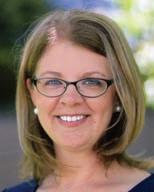
When your small business needs office, retail, restaurant, or industrial space, the communities of Northeast Ohio’s First Suburbs Consortium want to be your home.
If you’re a first-time entrepreneur, small business with one employee or a mid-sized company looking to expand, we offer great location, business assistance programs, and a genuine interest in being a partner in your success.
Learn more about available sites, properties, and small business programs at www.firstsuburbs.org/members-.html

Unlocking digital skills for small business success












In today’s rapidly evolving economy, small businesses face unprecedented challenges. According to the Verizon State of Small Business Survey, 82% of small business owners surveyed struggle with in ation’s rising costs and 72% feel nancially insecure, an increase from 66% the previous year.



In Ohio, these issues are felt all too well. About 2.2 million Ohians are dependent on small businesses for their jobs. And, according to a National Federation of Independent Business (NFIB) survey of its Ohio members, owners ranked in ation (48%) and staf ng shortages (28%) as the single greatest challenge to their operations at the end of last year.
As the world becomes increasingly interconnected, personalized tools for today’s digital economy are more important than ever.
As a technology provider, Verizon has a longstanding commitment to supporting small businesses, especially those owned by women and people of color in under-resourced areas. The latest effort in that mission is the launch of Verizon Small Business Digital Ready – a free online resource that brings together resources and incentives to support diverse small businesses with an integrated and customized learning plan.


Since its launch, more than 900 Cleveland-based small businesses have registered and engaged with the platform. To better support the roughly 49,200 small businesses in the greater Cleveland area, Verizon is partnering with local organizations like LISC Cleveland, the Northeast Ohio Hispanic Center for Economic Development, the Presidents Council, ECDI, the Union Miles Community Development Corporation and the Old Brooklyn Community Development Corporation.
The Verizon Small Business Digital Ready curriculum – built for and by small business owners and experts – provides in-depth assistance through end-to-end resources, including a mix of content, 1:1 coaching and mentorship, peer networking opportunities and nancial and non- nancial incentives that are integrated and customized based on a small business’ speci c needs.

Through Verizon’s work evolving the curriculum



and supporting small businesses across the country, here are three of the many ways we’ve seen owners and entrepreneurs grow their businesses through digital skills training:




1. Growing your customer base

Entrepreneurs who are adept at leveraging digital tools and platforms can reach a wider audience, attract potential customers and increase sales. With social media marketing, SEO and online advertising, small businesses can engage with target demographics and build brand awareness. By investing in technology skills, small business owners can harness the potential of digital marketing strategies and tap into the vast online marketplace.
2. Enhancing ef ciency and productivity

Digital tools have revolutionized business operations, enabling small businesses to streamline processes and improve productivity. By adopting new programs, collaboration tools and CRM systems, entrepreneurs are able to free up time to run their businesses and plan for the future. This empowers small business owners to leverage these tools effectively, enhancing ef ciency and driving growth.
3. Building resilience
Over the past few years, small business owners have been hit with a global pandemic, a constantly








changing economic landscape and workforce shortages. Remaining resilient – and implementing strategies that support this – is vital. With the right training, entrepreneurs can pivot their business models, embrace new revenue streams and engage with customers remotely. By leveraging e-commerce platforms, online marketplaces and digital systems, small businesses can remain ready for anything. Digital preparedness empowers entrepreneurs to navigate disruptions, positioning themselves for long-term success.
How we’re helping
In addition to digital skills training and tools, we all can play a role in preparing small businesses for the next chapter through capital support. For all of us, that includes shopping small and supporting these small businesses with our wallets. For local and national government of cials, that means pursuing legislation that champions small business owners. For individuals representing large corporations like ours at Verizon, that means partnering with small business owners and entrepreneurs to nd how our company’s funds and resources can help them achieve their goals. That can include training and grants; such as those offered through the Verizon Small Business Digital Ready platform, mentorship and resourcesharing, among others.
TOOLKIT: Assistance e orts beyond physical treatments could better help those with addiction. PAGE 13
RESOURCES: An ecosystem of local initiatives seeks to moderate the damage caused by drug abuse. PAGE 13
OPINION: Addressing both physical and mental health needs is key in treating substance use disorders. PAGE 15
OUR FIGHT against the opioid epidemic
Cuyahoga County is years ahead of other municipalities in spending millions of opioid settlement money
As states, counties and cities nationwide decide how to spend hundreds of millions of dollars from legal settlements with opioid distributors and producers, Northeast Ohio got a head start, and has spent years increasing e orts to mitigate the worst drug crisis in U.S. history. e opioid epidemic still persists, and
those on its front lines are focused on nding the best sustainable uses of the nite funding.

Cuyahoga and Summit counties were among the rst to allege in a lawsuit that drugmakers and distributors misrepresented the addictive risks of prescription painkillers, arguing the companies were dishonest with doctors and with the public about the drugs’ potential perils. at 2019 bellwether case resulted in a $320 million settlement for the two coun-
ties with opioid distributors and producers, including Teva Pharmaceuticals, Johnson & Johnson and others. Teva has since, in December 2022, nalized a $4.25 billion national agreement to settle claims that its marketing practices helped fuel the country’s opioid crisis.
Cuyahoga o cials continue to determine how to spend what’s left — $10.7 million as of March 2023 — of the settlement money on a profound need that a county o cial said may be greater than ever.
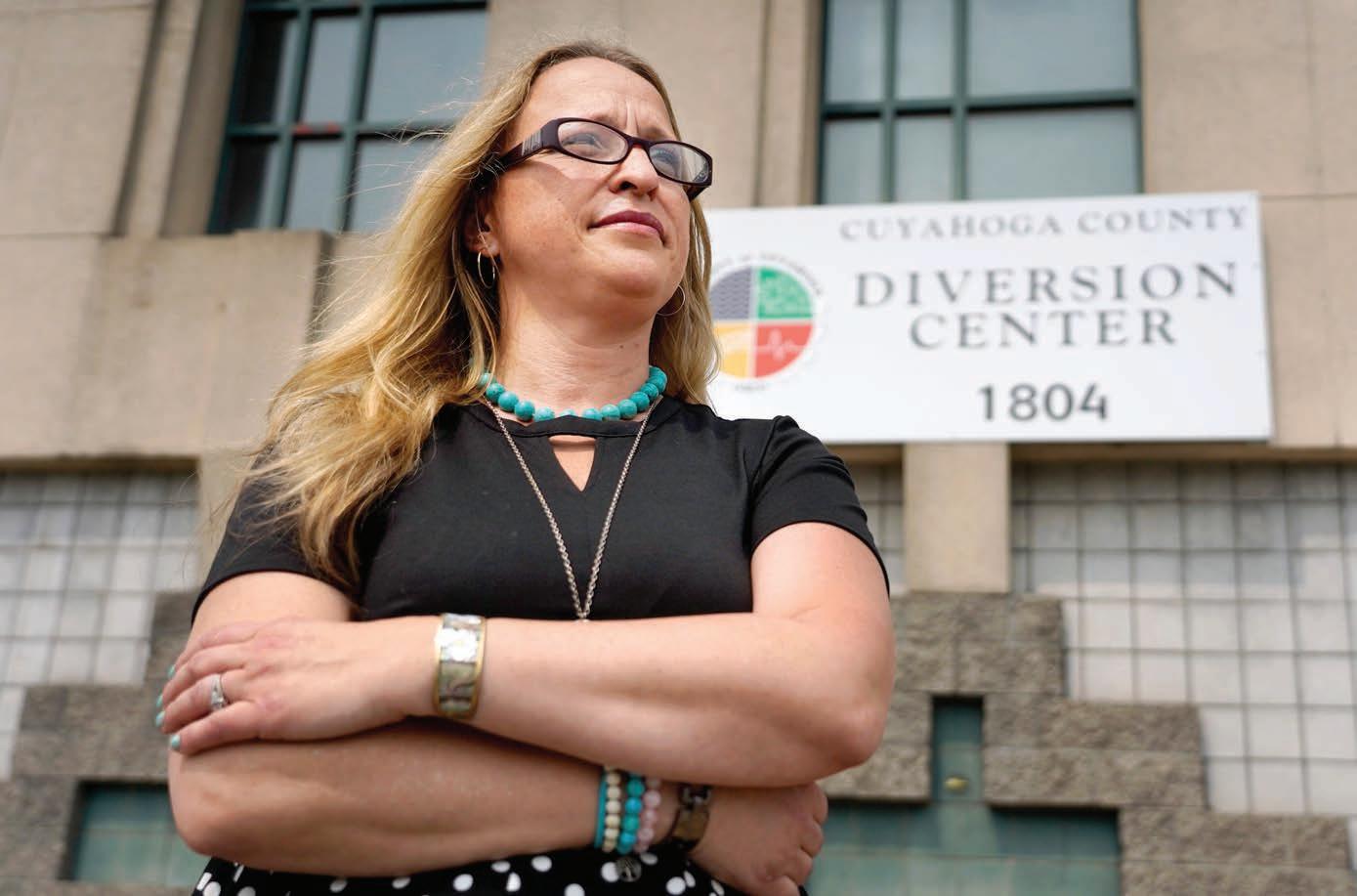
SPONSORS

“We had ve overdose deaths in one day during the rst week in June,” said Cuyahoga public safety and justice chief Brandy Carney. “Most everyone knows somebody with an awful story about this addiction — it hits everybody. Fire departments are working with EMS on the medical response. Since the opioid epidemic hit, you can imagine the time and resources spent responding to (emergency) events.”
Continued on next page
Per Cuyahoga County medical examiner statistics, 130 people have died from opioid overdoses through the end of March 2023. Victims range in age from 25 to 69, with deaths splitting along racial lines — 31 overdose victims were white, 19 Black and six Hispanic.
Cuyahoga, which has about 1.3 million residents, saw a 222% increase in drug overdose deaths from 2007 to 2017, the year the county led suit. e county recorded 727 drug overdose deaths in 2017, 556 of them due to opioids, according to gures from the National Institute of Health.
Opioids are a class of drugs that includes heroin, prescription-based pain relievers such as oxycodone and morphine, and synthetic opioids like fentanyl. e growing prevalence of fentanyl in the illicit drug supply is a top driver of rising overdose deaths across the United States. Fentanyl frequently appears mixed with substances including heroin, metonitazene or para- uorofentanyl — this last is known on the street as “China white.” In 2021 alone, about 80,411 Americans died from an overdose involving an opioid, according to the Centers for Disease Control and Prevention.
Where the money goes
More than half of the $125 million Cuyahoga received was used for a diversion center built to direct people with drug addiction and mental illness away from the county jail.
While the original purpose of the facility was to bring people in for treatment who would otherwise go to lock-up or the emergency room, the 50-bed center has since expanded to anyone in need of addiction services.
Located about 2 miles from downtown Cleveland, the center is overseen by the Addiction and Mental Health Services (ADAMHS) Board of Cuyahoga County. e county contracted FrontLine Service, a mental health nonpro t, to funnel calls from a 24/7 hotline directly to the facility.
As of December 2022, the center has admitted around 23 to 28 people each day, with an average stay of about ve to nine days.
“My main goal for the center is to either reduce our jail population or keep individuals out of the justice system altogether,” said Carney, who was on the front line of the initial settlement planning. “Get individuals all the help they need in a quality, supported environment to stop the vicious cycle.”
Along with education and awareness e orts to ramp up the treatment facility to full capacity, Cuyahoga is distributing funding to groups including the ADAMHS board and the MetroHealth System for treatment programs aimed at addicted inmates. Further grants are directed toward area addiction and mental health providers, while an additional $5 million has been earmarked for the creation of innovative new strategies to combat the widespread crisis.
Funding requests continue to pour in, and decision-making is of paramount importance, noted Carney.
“ is is one-time funding, so programs have to be sustainable and just can’t end in a few years,” Carney said. “So we are not funding a ton of projects. We prioritized the diversion
knowing it’s expensive to open up a new facility. We’re being intentional about prevention and harm reduction, but sustainability is always something to keep in mind, regardless of the program.”
MetroHealth procured about $7.7 million in total from the opioid settlement — a one-time $5 million allocation went to operation of a $42 million, 112-bed behavioral health and addiction center in Cleveland Heights expected to serve 5,000 patients annually. Additional dollars went to sterile syringes, county jailbased substance use disorder services and methadone treatments at the jail. Programs related to incarnated individuals are under the guidance of the hospital system’s O ce of Opioid Safety.
With a mission of education, advocacy and treatment, the o ce strives to erase stigma around substance use while o ering clean injection tools to prevent bloodborne pathogen transmission.
In the meantime, sta works with local colleges on opioid-based education for incoming freshmen. MetroHealth’s opioid safety department also educates emergency room personnel on how to treat those in crisis — this could mean the correct dosing of treatments like suboxone, one of the products Cuyahoga received in bulk as part of the federal settlement.
MetroHealth gets funding from multiple state and federal sources for its work around addiction. Yet, the hospital’s opioid team is always seek-
new caseworkers — MetroHealth used county dollars for a patient navigator who works with abuse disorder clients following their release from jail.
“We also added paramedics and nurses for withdrawal management and monitoring,” Domanski Diaz said. “In the past, we’d send people with withdrawal symptoms to the ER.”
Education is key
e COVID-19 pandemic may have been the public health issue to grab headlines in early 2020, but that does not mean Northeast Ohio’s opioid problem has gotten better, said MetroHealth’s Papp. However, the hospital did not see funding completely shift to virus management — federal dollars allowed MetroHealth to deploy a mobile unit carrying clean use kits and overdose-reversing naloxone medications.
e hospital also has authority over how it spends its settlement dollars. As addiction and mental health are intimately connected, MetroHealth is better able to monitor individuals through the critical rst week of treatment, Domanski Diaz said.
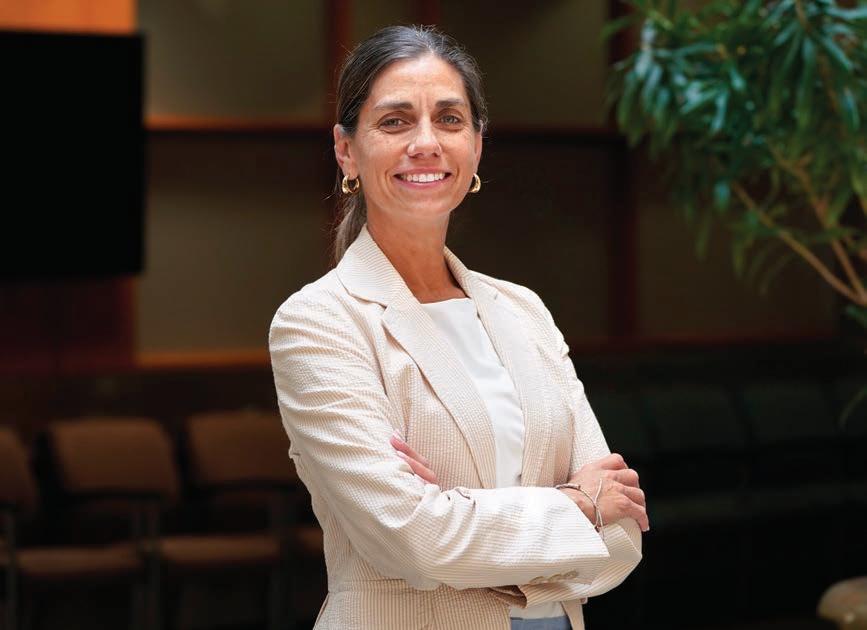
“Cuyahoga did a good job identifying evidence-based needs, like the focus on the work going on at the jail,” she said. “We know that people released from jail have a higher overdose rate (than the rest of the population), and many of these people have uncontrolled addiction and mental health diagnoses.”
e nite nature of the funding has MetroHealth o cials concerned about how to keep this population safe. Creating lasting programs requires policy change around reimbursement, as well as education that reduces the stigma around opioid care, even among providers, Papp said.
“ ere’s a support system that must be in place for transportation and for barriers like housing and childcare,” she said. “It’s hard to worry about addiction when you’re living under a bridge and have nowhere to go.”
While medication and therapy are obvious uses for the remaining county dollars, a portion of this funding must also go to caregiver training, Papp added. Educating providers about opioid addiction can eliminate myths that surround the disorder — mainly that addiction cannot be treated like a regular medical problem.
ing external dollars for work that can be a drag on resources, said director Joan Papp.
“Insurance companies pay for services, whether Medicaid or private insurance,” said Papp. “But if a case manager works with a patient on making appointments or arranging transportation, that is not going to be reimbursed. is work is vital to the next step of care for this population. We’re looking to fund programming long term that becomes best practices.”
Sustainability is a target for MetroHealth in mitigating the cycle of drug abuse and incarceration at the county jail as well, said Laurel Domanski Diaz, administrator of correctional medicine for the health system.
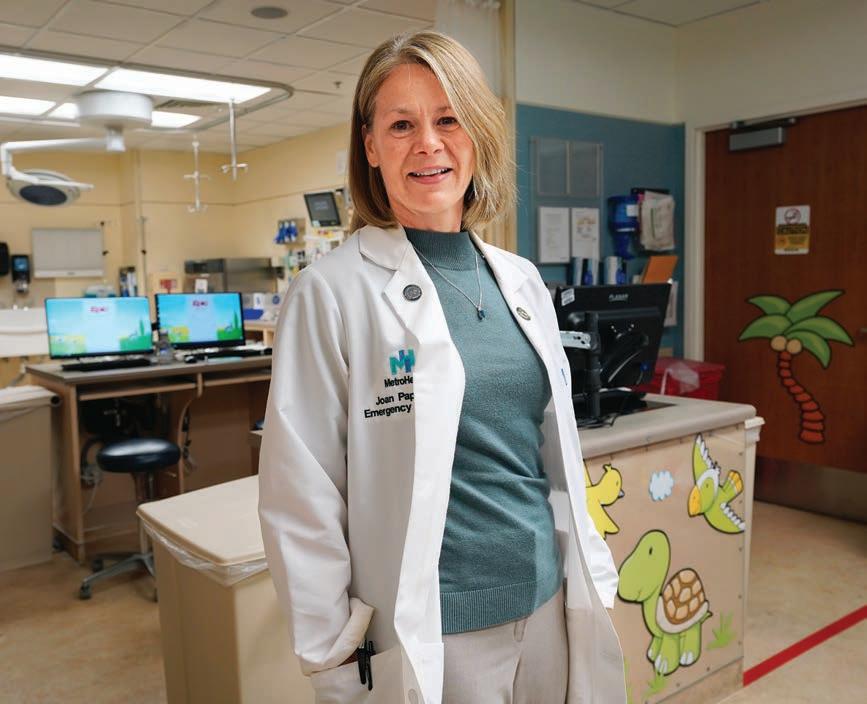
For example, funding is needed for
“Some providers are just unaware of the interventions,” she said. “And working with this population can be challenging for clinicians. ey take time and resources, which makes it hard for providers to want to take them on. So our goal is to educate providers on what these best practices look like.”
For instance, the Drug Enforcement Administration eliminated the waiver for suboxone prescriptions at the start of the year, allowing clinicians to recommend the drug for opioid use disorder. A lack of training discouraged some caregivers from o ering the medication despite its low risk for respiratory depression when taken as prescribed, Papp said.
“Providers must know how to safely prescribe these medications,” she said. “ e big lesson is we need to change how we pay for these ser-
vices, because we can’t do this work with one-time funding. County funding is helpful in building the foundation to launch these programs, but fully sustaining and keeping them will require policy and regulatory change.”
A need for more housing
e regional health care emergency presented by opioids is getting worse, particularly as users combine synthetic opioids with cocaine and other stimulants, said Daniel Lettenberger-Klein, CEO of Stella Maris, a detox and rehabilitation treatment center on Cleveland’s West Side.
In Cuyahoga, overdoses from cocaine and fentanyl mixtures increased 85% from 2020 to 2021, per data from the county medical examiner’s o ce. Border shutdowns during the height of COVID temporarily stopped distribution of pure heroin, resulting in increased fentanyl use and further experimentation with cocaine and methamphetamines.
Mixing opioids with di erent drugs is resulting in typical opiate withdrawal symptoms — anxiety, nausea and muscle cramps — sometimes followed by the paranoia and hallucinations that traditionally presented themselves in the rst days of treatment, said Lettenberger-Klein.
New problems necessitate novel therapeutic approaches, added the CEO.
Stella Maris, which, as Ohio’s oldest treatment center, has been providing addiction and mental health services to Greater Clevelanders since 1948, obtained a total of $11 million from two rounds of the federal opioid settlement. Money will be used to add 32 residential treatment beds along with campus updates and expansion of the center’s intensive outpatient, medication-assisted treatment and partial hospitalization programs.
A mid-20th century focus on sober housing for longshoreman has now evolved into 24/7 residential treatment for addiction and withdrawal management. Stella Maris clients get therapy from a team of nurses, care managers and psychiatric professionals during average stays of 28-45 days.
center has been beneficial, the region still needs more sober and supportive housing for substance abuse patients, Lettenberger-Klein said.
Ideally, county dollars will also be harnessed for workforce development in behavioral health, creating partnerships among universities and care organizations for a eld with prevalent wage disparities. But, while it’s a key position in opioid use disorder treatment, the average behavioral health specialist in Ohio makes just over $52,000 annually, according to Zip Recruiter.
“Someone can go to a hospital and do this work for way more money than they get here,” he said. “Funds from the county can help o set those wage gaps so organizations like us can pay competitive wages. If we don’t have parity of pay, we’ll always su er from workforce shortages.”
An environment of outreach
Schools can play their part in opioid education and prevention, said Lettenberger-Klein. His “piein-the-sky” ideal is the Urban Community School model, which directly communicates with faculty, families and community partners in eliminating the silos that block access to food and other basic needs.
“Why not create something impactful and not repetitive that informs the entire care system?” he said. “ e best place to inform the entire system is where you can best engage the whole family unit, which very often is school. It’s an opportunity to engage families with age-appropriate education on opioid addiction.”
Scare tactics preaching the harmful e ects of opioids are generally ine ective, said Ted Parran, a professor at Case Western Reserve University School of Medicine and co-medical director of Rosary Hall, a hospital-based addiction treatment facility at St. Vincent Charity Medical Center.
Parran, whose center received $2 million in opioid settlement money, believes more funding is needed for the teaching of parenting skills.
A “prevention curriculum” that aims to, at the very least, shift the age of experimentation among children and teens would be similarly bene cial, he said.
More ways to ght addiction
While opioid treatment, both inpatient and out, and physical support for those with addiction dominate funding priorities, Northeast Ohio's addiction experts say that there are many types of assistance that could better help those with addiction and improve people’s long-term success:
Related services
While addiction treatment often receives direct funding, aspects of that treatment such as booking appointments and transportation to them — and child care as a patient is receiving treatment — often do not and that can a ect success rates for people trying to nish a program. Caregivers increasingly are looking at mental health services as part of a holistic approach to mitigating addiction. Higher pay for behavioral health therapists would help expand the eld and its availability, many believe.
Medical strategies
Drug treatments, therapies, medication and procedures for those with addictions are evolving, and medical experts say an ability to implement best practices and promising strategies more quickly and e ciently could help more people faster.
A system that puts in practice a variety of methods would help medical and mental health professionals identify ways to target treatment to speci c individuals more e ectively.
Education
In age-appropriate ways, children and young adults should get information about substance abuse and addiction. A "prevention curriculum" that gives teens information and facts about drugs and addiction can often prevent or delay experimentation, helping to limit their curiosity and exposure. More training for emergency medical crews can boost their ability to help those with critical needs get life-saving care.
Innovation
Funding that allows for research and development of new strategies and technologies is needed to help expand the ability to ght opioid addiction and to make current strategies more e ective. Implementing new strategies may take time and can be expensive; a pool of funding set aside for the development of new tools to ght addiction can help treatment facilities put them into practice.
Resources in Northeast Ohio
The nature of the Cuyahoga County’s opioid threat has changed in recent years, with fatal overdoses from fentanyl increasing while heroin deaths have plateaued. As the emergency continues to evolve, an ecosystem of local resources seeks to moderate the damage caused by opioid abuse.
` Addiction and Mental Health Services (ADAMHS) Board of Cuyahoga County: (216) 241-3400
` Cleveland Clinic Alcohol and Drug Recovery Center: (216)444-5812
` MetroHealth O ce of Opioid Safety: (216) 778-5677
` Rosary Hall o ers drug treatment and rehabilitation at its location at St. Vincent Charity Medical Center downtown: (216) 363-2580
` Stella Maris, a detox and rehabilitation treatment center on Cleveland’s West Side: (216) 781-0550
` Take Charge Ohio provides addiction treatment resources, as well as information on how to dispose of unused medication: 877-275-6364
` Addiction Recovery Services at University Hospitals: (216) 844-5566
` Women’s Recovery Center, a Cleveland-based addiction treatment facility for women and their families: (216) 651-1450
` VA Northeast Ohio Healthcare System: 800-698-2411
Shining a light on addiction
Ohio o cials continue to ght an opioid crisis that signi cantly impacts the state’s most at-risk populations. In June, Ohio’s Dave Yost joined other attorneys general around the nation to secure a 15-year, $679.6 million settlement — part of a combined $17.3 billion national payment that held drugmakers and pharmacies accountable for their roles in the opioid emergency. Funding from that settlement could start owing to state and local governments by year’s end or early 2024.
In December 2022, Teva Pharmaceuticals nalized a $4.25 billion national agreement to settle remaining claims that its marketing practices helped fuel the country’s opioid crisis. Under the deal, Teva will make payouts over the next 13 years to approximately 2,500 state, local and tribal programs impacted by the ongoing epidemic.
County safety o cial Carney advises jurisdictions in line for funding to take money, not donated products. In Cuyahoga, certain medications provided by the previous settlement were not used by local EMS crews or disrupted the model in how such interventions were ordered and replaced. e cash component was more straightforward, as the county consulted with health facilities and other organizations on how to utilize funding.
Even as the need for programming escalates, Carney knows how quickly $125 million can be spent. Raising awareness among K-12 students should be an ongoing strategy; just as pressing is improved opioid emergency training for rst responders.
“Lots of police and re ghters are not trained to de-escalate,” Carney said. “ is is an opportunity to help out on the response rather than creating a crisis. We would love to keep these people out of prison.”
Long-term solutions for opioid addiction are in play, as well. Last summer, Cuyahoga County Executive Armond Budish proposed a $10 million Opioid Innovation Fund to support new strategies for combating the epidemic. e program has set aside $5 million in settlement funds thus far, to be invested in promising technology and systems for preventing or treating opioid dependence. An advisory board that includes Lettenberger-Klein of Stella Maris will be part of the brainstorming process, as well.
“Client care drives the business plan,” Lettenberger-Klein said. “We have a wait list for every single bed here, so our priority is providing more beds and increasing infrastructure. We want to expand every point in the care continuum.”
Stella Maris serves 4,000 clients annually, a gure that will increase to 6,000 once the center is at full capacity. e organization currently takes patients from the new county diversion center, a crucial service following discontinuation of inpatient care at St. Vincent Charity Medical Center downtown.
Though the county treatment
“Without prevention it’s harder to identify addiction,” said Parran. “Most kids will grow out of experimentation, but it’s di cult to gure out which ones have the disease. Delay experimentation as much as possible, and if kids do use, they should know to do it in smaller amounts”
Additional housing for people on medication-assisted treatment, or MAT, would provide the wholesale intervention currently scarce in the recovery landscape, as many methadone clinics use only one type of medication to treat opioid use.

“ is would be transformational for people who don’t have a safe place to put their head on the pillow at night,” he said.
Councilman Jack Schron, whose district encompasses communities from May eld to Brecksville, envisions software that can reprogram the addictive brain or technology aimed at the disposal of prescriptions to decrease their abuse. Although there is no guarantee these will be e ective, proponents believe they are worth the risk.
“Is there a product, process or software that can be developed to help solve addiction?” Schron said. “We want front-edge ideas. We already have the treatment side, now we need the front-end side. Someone has to start with those ideas.”
Cuyahoga’s head start on funding may not be an end-all solution itself, but it does shine a light on an epidemic, Carney said.
“As simple as it sounds, we want to save lives, and not be in a place where year after year we have these awful numbers,” she said.
Contact Douglas J. Guth:
clbfreelancer@crain.com

“WHY NOT CREATE SOMETHING IMPACTFUL AND NOT REPETITIVE THAT INFORMS THE ENTIRE CARE SYSTEM?”
—Daniel Lettenberger-Klein, CEO of Stella Maris
More lives can be saved, but change is needed
DR. JOAN PAPP AND MELISSA FEDERMANAs an emergency physician at MetroHealth since 2001, I have had a front row seat for the opioid epidemic in Cleveland over the past two decades. Early in my career and soon after the Joint Commission mandated that hospitals measure pain as a vital sign or risk their accreditation status, we saw the rst signs of the crisis developing.
roughout this time, the pharmaceutical industry promoted prescription painkillers as a safe and non-addictive therapy to reduce pain and improve pain scores. We now know those claims were false.
Doctors realized early on that their patients were becoming addicted to the medications they prescribed but didn’t have the knowledge or support to provide the care they needed. Regulators also saw the damage and blamed the prescribers, causing fearful doctors to turn their backs on addicted patients. Patients, desperately sick in withdrawal, tuned to an unregulated, inexpensive alternative: heroin and its powerful synthetic cousin, fentanyl. ese drugs, often injected, lead to interactions with law enforcement and chronic infections like HIV and hepatitis C.
So where are we now?
e fallout from this transition to illicit opioids led to the loss of 656 lives in Cuyahoga County from overdose in 2022. is year we are on track to have the highest overdose mortality since the crisis began. Contributing to this devastation is the pervasiveness of fentanyl — in ltrating the drug supply of nearly every illicit substance on the street.
Initially an epidemic primarily impacting white males, we are now seeing the highest overdose rate among people of color, with non-His-
panic Blacks dying at a faster rate than any other demographic of drug user.
How do we get out of this?
Fast forward over a decade and MetroHealth has implemented comprehensive opioid stewardship programs resulting in reduced prescribing, safe and e ective taper protocols, community-based prevention, and treatment for opioid use disorder. e reality is, we had tens of thousands of Ohioans addicted to opioids for decades and it will take at least that many years to support their recovery.
e opioid settlement funds have given us the opportunity to get vital programs o the ground, but they are time limited. To turn the tide, we will need comprehensive, sustainable change within a framework that places the person in the center and builds resources around their needs.
Current programs funded by the settlement dollars t well in the social-ecological model: peer support, jail-based addiction programming and inpatient addiction and mental health care — yet we still have major gaps. Existing addiction programming needs to be augmented to develop processes to identify and eliminate disparities and increase access for people of color. Our patients also need access to food, housing, transpor-
tation, Spanish language services and wraparound care to support their success in recovery.
e question now is: How can we continue to pay for the programs that are working and how do we expand to support unmet needs when settlement dollars are exhausted?
We can start by requiring payers to reimburse for treatments that are proven to work. Medications for opioid use disorder are the standard of care — proven to increase engagement in addiction care, decrease illicit drug use and reduce overdose mortality, yet in a 2020 Substance Abuse and Mental Health Services Administration report, only 16% of patients across all addiction treatment settings received any form of medications for opioid use disorder.
It takes an entire community to ght addiction
Cleveland, we are still in a devastating opioid epidemic. is epidemic was raging before the COVID-19 pandemic, and it didn’t go away. People are dying in every corner of our community from drug overdose, and no one is immune. Like it or not, the new “normal” in our society is that we all are impacted in some way by addiction and/or mental health issues.
On the front lines, we are seeing an increase in mental health issues, a ood of synthetic drugs that lead to more severe intoxication and withdrawal, and an overworked health care system. Over the last year, we have seen an increase in clients with signi cant mental health co-occurring disorders; an increase in aggressive and paranoid patients during the prolonged withdrawal process; an increase in polysubstance use including alcohol and opioids in combination with one another, and an increase in methamphetamine as the primary substance.
Xanax or Adderall only to be revealed by the coroner it was cut with synthetic drugs.
Fortunately, we do have efficacious treatment options; we just need the entire community to be a part of the recovery. Since 1948, Stella Maris has been taking care of Greater Cleveland. Many readers may know of Stella Maris, but few know we are the oldest drug and alcohol treatment provider in Ohio.
Since our inception, we have been working to return friends and family to their loved ones and help the hard-working people of Cleveland return to work. Our mission is to provide transformational care to those struggling with addiction and mental health issues regardless of race, religion, gender, gender identity, or ability to pay. is mission, along with our passion and dedication to those in need, keeps us laser focused on always evolving.
covery housing, psychiatric services, trauma therapy, case management, family therapy, art therapy, equine therapy through Fieldstone Farms, group therapy, music therapy in partnership with e Music Settlement, 12-step groups, medication assisted treatment (MAT), post-acute withdrawal management, peer support, and a workforce development program that includes one-on-one coaching, interview practice, goal setting and culinary training.
Specialized care is provided to veterans, individuals experiencing homelessness, survivors of human tra cking and domestic violence, and the LGBTQ+ community. Roughly 95% of our clients are at or below the national poverty level, and many have experienced or are currently struggling with homelessness.
We care for a largely Medicaid dependent population who often struggle to remain engaged in both the workforce and family life.
e work that happens on our campus focuses on the restoration of hope and the art of recovery. We work diligently to ensure Stella Maris is a place where all people feel welcome and safe. We also have an incredible co ee shop open seven days a week that is open to the entire community (please come visit)!
Programs that cling to ine ective abstinence-based programming are still funded with state and local dollars, which diverts funds from evidence-based programs and place patient lives at risk.
To sustain services, payment should be on par with reimbursement for other medical care, and recovery supports need to be funded to make change permanent. Medical care, including addiction treatment in jails and prisons, should be reimbursed through typical payors including Medicaid, Medicare and commercial insurers rather than through independent contracts, competitive grants and other external funding sources.
Most people entering jail have a substance use disorder — often co-occurring with a men-
Exacerbating this is an increase in overdoses that are resistant to naloxone (Narcan) over the last 12 months. Further, many clients are testing positive for substances they claim they have never knowingly used. Cocaine users are dying of overdoses because their drugs are unknowingly laced with synthetic opioids or other drugs. High school and college students are dying because they bought a pill thinking it was a
We don’t grow for the sake of growth; we do it because without the additional bed or chair, someone may die.
Our campus in Ohio City is unique in that we provide all levels of addiction treatment from inpatient medical stabilization (detox) through outpatient clinical and medical treatment. Our mission to provide people the care they deserve means providing wraparound services, including primary medical care, re-
Our organization, along with countless others providing care for those most vulnerable throughout our community, must be compensated appropriately. Increased funding is happening, but not nearly at the rate required to cover the increased labor costs that have soared since COVID.
The Cleveland area is rich with academic institutions, which means the community organizations, local and state government, academic institutions and philanthropic organi -
zations must work together to ensure a strong pipeline of health care professionals who know that their investment will not only lead to a fulfilling caregiver position, but also one that can support an independent lifestyle.
Despite some of what I shared, there is reason to be hopeful. You can make a difference. Whether it is supporting the nonprofits that do great work (Stella Fest-75th Anniversary!) or connecting with that person you aren’t sure what to say to, please do what you can. We are only as strong as the work we are willing to do.

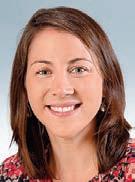



WE DON’T GROW FOR THE SAKE OF GROWTH; WE DO IT BECAUSE WITHOUT THE ADDITIONAL BED OR CHAIR, SOMEONE MAY DIE.
tal health diagnosis. e federal mandate to turn o a person’s medical coverage when they are incarcerated decreases the overall consistency, quality and access to this already scarce resource.
Lastly, stigma and prevention must be addressed collaboratively. Stigma negatively impacts every aspect of policy, equity, medical care, community support and an individual’s sense of self-worth — all of which impact opioid use and treatment. Prevention — by training health care providers, increasing access to mental health services and increasing public awareness — will all decrease stigma and is the key to halting the next generation from picking up an opioid or other illicit drug.
Addiction treatment with mental health aid key
Janice* was sexually abused by a close relative starting at a young age. Her abuser died when she was 12, and she cried tears of joy. She started drinking with friends to cope with the unfounded guilt and self-loathing she felt.
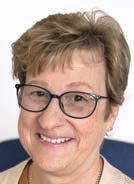
Within a few years, drinking turned to drug use, and she spiraled down.
She had no idea the demon she was dealing with was post-traumatic stress disorder. At 21, she was prescribed oxycontin for wisdom tooth pain and her addiction to opioids only got worse.
Ten years and several prison terms later, she was released and came to Coleman. She was assisted with medical management of both her mental illness and her addiction. She received counseling, both individual and group. Coleman sta helped her nd housing and, once she was doing better, to nd a job.
Janice is doing very well and continues to follow her care plan.
At Coleman, we o er many services to those with opiate use disorders who more often than not have a co-occurring mental health diagnosis and other substance use disorders. We believe that it is the expectation rather than the exception for there to be a co-occurring diagnosis and that by simultaneously addressing both disorders, we provide the best opportunities for recovery.
Our crisis intervention services meet persons of all ages at their time of need and will assess substance use as part of any suicide assessment. If someone may be better served by withdrawal management or substance use treatment, we facilitate these referrals and consider those referrals as an alternative to psychiatric hospitalization wherever possible. Relationships with our local systems of care are important to help match a person’s needs with the best care available. If a person enters our withdrawal management program in Lima,
their withdrawal is medically managed while simultaneously managing their psychiatric symptoms.
Coleman has Crisis Stabilization Units (Stark, Portage and Allen counties) for people who are not in need of acute medical monitoring for withdrawal symptoms but may be su ering from symptoms of a substance use disorder and a mental health disorder. is level of care provides around-theclock monitoring and support during a transition between higher levels of care or need and a lower level of care such as intensive outpatient or other outpatient services.
Medication Assisted Treatment is provided through Coleman Health Services (CHS). Under the supervision of our skilled and experienced clinicians, CHS provides medications that are used as invaluable tools to support and foster a person’s ability to stay o opioids. Knowing that medications such as buprenorphine and naltrexone are not the only solution to a complex problem, our team of psychiatry providers also diagnose and treat co-occurring mental disorders while also engaging with the team to provide all aspects of care.
Coleman sta view the person with addiction as a whole person, each having individual medical, psychological and social service needs to support their recovery.
Substance Use Intensive Outpatient services as a level of care, assist people in initiating recovery, stabilizing and maintaining recovery. We have chosen curricula for our Intensive Outpatient Services that support recovery from substance use but also address the trauma and related mental health issues that often co-exist. Seeking Safety is an evidence-based group treatment model for those seeking recovery that emphasizes the presence and resolution of trauma and related mental health disorders that complicate substance use recovery.
To address social determinants of health, Coleman o ers case management, peer services and supportive employment. Coleman owns and operates several supportive living, and many independent community living, units in and around our Coleman locations. While these generally are mental health-focused care, we can o er housing to many who have co-occurring mental health and substance use disorders.
From a prevention perspective, CHS partners with our local mental health and recovery boards and health departments to educate sta and clients around Project DAWN (Deaths Avoided With Naloxone), a network of opioid overdose and naloxone distribution programs coordinated by the Ohio Department of Health.
All these services are provided with the mission of helping all people with addictions and mental health disorders so they can recover and become successful, like Janice.
(*Name changed to protect her identity.)
Financial advisers can be a key ally in addiction recovery

An unexpected ally has joined the ght against opioid addiction — nancial advisers. Substance use disorders are a ecting every industry and thousands of families, which mobilized this innovative partnership to help nd a solution.

Opioid addiction takes a terrible emotional and physical toll on both the people living with addiction and on their loved ones. It also can have a devastating nancial impact on everyone involved. Financial advisers estimate that opioid addiction by just one family member can cost $35,000 per year.
Finances should not be a barrier to receiving necessary addiction care. My agency, the Alcohol, Drug, Addiction and Mental Health Services (ADAMHS) Board of Cuyahoga County, plans, funds and monitors the local public mental health and addiction system. We are known as a “safety net” that helps the most vulnerable and highest need individuals to connect to care.
e State of Ohio just passed a favorable budget for behavioral health, which maintained funding to ADAMHS Boards and improved access care by promoting and implementing the 988 National Crisis Lifeline across all communities.
But the new state budget does not undo decades of underinvestment in mental health, addiction and recovery services. Families often take the burden of these costs, and must make devastating choices.
When an individual sits down with a nancial adviser, they expect to talk about college, vacations, retirements, investments and building wealth, not about managing the costs of their own or a loved one’s addiction.
Financial advisers have become an unexpected connection to treatment, resources and information for families. e State of Ohio launched a campaign, “Recovery Within Reach,” to support nancial advisers through a continuing education course on the prevalence and e ects of Substance Use Disorders (SUD), its nancial consequences, and the active role thatnancial professionals can take to assist their clients.
We do know that treatment works, and recovery is possible. Statistics from the U.S. Surgeon General’s Report on Alcohol, Drugs and Health show that about 50% of people who have a substance use disorder are in stable remission, meaning they have not used drugs for over a year. e report also found a higher success rate for those who participate in a treatment program.
ousands of Cuyahoga County residents are living in recovery from substance use disorders, including opioid addiction. e ADAMHS Board supports a continuum of care that includes prevention, withdrawal management, Medication Assisted Treatment (MAT), non-medicated treatment, counseling, sober housing, and peer support. We piloted and continue to support various harm-reduction approaches, like fentanyl test strips that detect fentanyl in heroin and other substances to reduce the number of deaths by overdose, naloxone (Narcan) kits to reverse opioid/heroin
overdoses, and even Narcan vending machines in select locations.
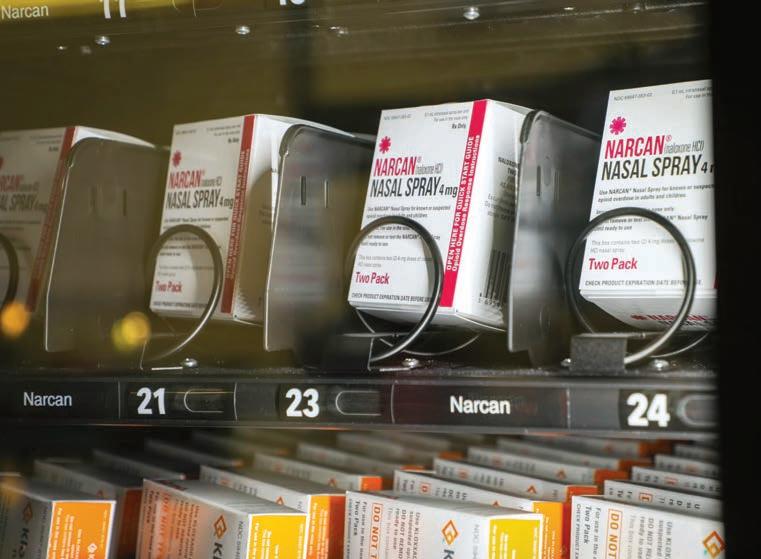
The finance sector may be an unexpected partner in our society’s struggle against addiction. The truth is that opioid addiction is a damaging problem that requires not only all the proven prevention and treatment methods that the ADAMHS Board funds, but awareness and education by every sector and every individual. We are all affected by this
disease.
Learn more about Recovery Within Reach at recoverywithinreach.ohio.gov. In Cuyahoga County, residents can contact the Cuyahoga County 24-Hour Suicide Prevention, Mental Health/Addiction Crisis, Information and Referral Hotline at 216-623-6888 to access information and nd treatment, or visit adamhscc. org to register for trainings for yourself or your workplace.
| ADAMHS
WE BELIEVE THAT IT IS THE EXPECTATION RATHER THAN THE EXCEPTION FOR THERE TO BE A CO-OCCURRING DIAGNOSIS AND THAT BY SIMULTANEOUSLY ADDRESSING BOTH DISORDERS, WE PROVIDE THE BEST OPPORTUNITIES FOR RECOVERY.
NOMINATE NOW
Nominate a commercial realtor who demonstrates an innovative approach to marketing commercial properties.
Nominations Due September 1
CrainsCleveland.com/NotableNoms
Five issues that Northeast Ohio’s mid-majors are watching
One of Randale Richmond’s favorite sayings is, “I try not to borrow trouble from the future.”
e Kent State athletic director is usually smiling when he says it — “ at’s how I keep my anxiety down,” he adds — but just because he doesn’t agonize about the future doesn’t mean he doesn’t prepare for it.
“We talk all the time about what the future landscape of college athletics could be, and what that means for Kent State University, and how we need to be prepared for that,” he said.
e same is true at Northeast Ohio mid-majors such as Akron and Cleveland State, who are navigating a Division I landscape that is undergoing massive changes, from Name, Image and Likeness opportunities to legalized gambling to increased exposure for women’s athletics to conference movement (and consolidation), and more.
Crain’s recently spoke with the athletic directors at those schools — Richmond, Scott Garrett (CSU) and Charles Guthrie (Akron) — about those topics, as well as their thoughts about potentially expanding the NCAA basketball tournament.
Here’s what they said.
NCAA tournament expansion
Earlier this year, the NCAA Division I transformation committee suggested that team sports sponsored by more than 200 institutions consider expanding their postseason elds to 25% of the teams that meet the standard in the sport.
at’s a very academic way of saying that if you have 363 Division I basketball teams, you should consider expanding the tournament from 68 teams to about 90. (Or even 96, since that would make bracketing easier.)
In theory, expansion would be a no-brainer for the Mid-American Conference (which includes Akron and Kent) and the Horizon League (CSU). e MAC hasn’t placed two teams in the men’s tournament since 1999, while the Horizon League hasn’t done so since 2009. e SEC and the Big Ten, by contrast, each had eight teams in this year’s tournament alone. More berths means more money for those conferences.
“ at always sounds good,” Richmond said of expansion. “But I think when you expand it, it’s not the Kent States and the Mid-American Conference schools that get in, it’s probably some of those other (Power Five) schools. I’m not sure that’s the answer.”
If the tournament does expand, Garrett would like to see automatic bids go to regular-season champions that don’t win their conference tournament. Currently, only the MAC/ Horizon conference tournament champions get automatic bids, which was a good deal this season for tournament champions Kent and Northern Kentucky, but not for regular-season champions Toledo (MAC) and Youngstown State (Horizon).
ose regular-season champions do get automatic berths in the NIT, the basketball equivalent of when “Jeopardy!” gave losers a year’s supply of Rice-A-Roni.
“ ere’s so much at risk in a one-
bid league,” Garrett said. “You can have a really awesome season and win the regular-season championship, then you have one bad game over the weekend in March, and you’re not able to celebrate that special season. Maybe there’s a way to roll all those NIT slots into the main NCAA tournament.”
e key, Garrett said, is not to mess up a good thing.
“ is tournament is special and has such a strong tradition,” he said. “But it has gone through expansion as Division I has grown. Depending on how it’s structured, it could be advantageous for schools like us.”
Women’s sports
is year’s NCAA women’s basketball tournament championship between LSU and Iowa averaged 9.92 million viewers, shattering the previous record of 5.7 million for a women’s tournament game, set in 2002 when UConn beat Oklahoma for the title. is year’s tournament also set a record for highest tournament attendance at 357,542.
It was seen as a breakthrough for women’s sports at the college level, which has spent decades ghting for equal treatment when it comes to things like media coverage, revenue and resources.
“Women’s basketball, softball, volleyball and gymnastics — people are starting to see the individual value of some of these female sports, and that’s a beautiful thing,” Richmond said. “ ere’s a long history of Kent State success in these sports. ... It tells a great story about the power of access and opportunity and the product that you can then provide.”
Cleveland will host the women’s Final Four in 2024, and Garrett said CSU plans to involve its athletes, students and fans in the programming around the event.

Garrett also wants to build on the success of this year’s women’s basketball team, which had a 16-game winning streak and made the NCAA tournament for the rst time since 2010.
But while local initiatives are good,
the growth in women’s sports must happen at the national level, which is why Guthrie wants to see the NCAA do a better job marketing the women’s basketball tournament.
“ e women’s NCAA tournament is starting to show some value through all the eyeballs on the game,” he said. “I’m interested to see how our organization handles the upcoming contract with NCAA women’s basketball and some of our other women’s sports. Softball is o the charts on television. Volleyball is attracting big crowds. ose are growth opportunities for our organization, as well.”
Conference consolidation
e MAC is the most stable conference in the country, with its 12 full members all joining between 1946 and 1998. e Horizon League hasn’t been quite as lucky, with former members like Butler, Loyola-Chicago, Valparaiso and Illinois-Chicago all moving to higher-pro le leagues since 2012.
But the Horizon at least makes geographical sense, unlike the Big Ten, which is about to stretch from New Jersey to California. Adding USC and UCLA might work when you’re lling a 12-game football schedule with Saturday games, but it doesn’t work for other sports.
“I’m hoping common sense takes over in college athletics,” Guthrie said. “Even if we go to a pro model, the New York Yankees aren’t always going all the way out to L.A. to play the Dodgers. e New York Mets play a regional schedule in their backyard, which keeps their players healthy, keeps travel light, preserves careers and allows their families to actually go to an away game without having to travel 3,000 miles.”
Akron, CSU and Kent aren’t looking to move conferences, but they’re very aware of how conference movement a ects their leagues. e Power Five conferences — the Big Ten, SEC, ACC, Big 12 and Pac-12 — are getting bigger and richer, which makes it harder for mid-major schools to compete when it comes to TV con-
cord company, and even though he sold a lot of records at one point, he was compensated based on the deal he signed,” he said. “He renegotiated later on down the line as his records got bigger and bigger.
“The challenge we have with Name, Image and Likeness right now is that everybody is throwing out dollar figures and nobody knows the true value of it. Statistics could say that a basketball player is worth $800,000, but where is that data to suggest that? There is no data.”
And if a player does prove to be worth $800,000 or $1 million? Nobody will complain about them getting paid that amount, Guthrie said.
“But if you’re on Instagram and you’ve supposedly got 300,000 followers and only 20,000 are authenticated, is that really your value?” Guthrie said.
Gambling
tracts, facilities, NIL opportunities and more.
“We’re always paying attention,” Guthrie said. “As I’ve said before, if you continue to drive a yellow cab in a world with Lyft and Uber, you’re going to be left behind. e (MAC) commissioner realizes that and understands that. We can’t sit back and think that realignment isn’t going to knock on our door or impact us.”
Case in point: e MAC nearly added Western Kentucky and Middle Tennessee State two years ago when Conference USA was on the verge of collapse.
“ ere are a lot of things that are enviable about us as a conference,” Richmond said. “With that being said, the commissioner’s job is to always see if there are other opportunities out there that make sense for our purpose and our mission as a conference.”
Name, Image and Likeness
All three universities have partnered with Opendorse to create school-speci c NIL platforms over the past year, allowing student-athletes to capitalize on opportunities while adhering to state law and NCAA regulations.
But NIL is still in the Wild West stage. is is where being a mid-major actually can be an advantage, Garrett said, since their athletes aren’t earning million-dollar NIL deals.
“ e mid-majors and lower-visibility Division I schools have a little bit of a longer runway to gure things out,” he said. “It’s not a ecting us as rapidly from a competitive standpoint, but we also need to make sure we’re competitive amongst our peers. We’re not an Ohio State or Cincinnati, but we need to pay attention to what’s happening at schools like Toledo, Bowling Green and Miami.”
Guthrie believes the NIL market will sort itself out in time, comparing it to Hollywood or the music industry “who have been doing Name, Image and Likeness very well for a long time,” he said.
“Michael Jackson signed with a re-
Last month, the NCAA’s Division I legislative committee announced more lenient guidelines to some of its gambling policies. Student-athletes can still permanently lose their college eligibility if they’re found to be throwing games, in uencing outcomes, providing insider information to bettors or wagering on their own games or other sports at their school.
But the punishments aren’t as harsh for other infractions. For instance, athletes who gamble on their own sports at other schools will be required to take educational classes on sports wagering and could be suspended for 50% of the season. As for athletes who wager on pro sports, the NCAA’s punishment will depend on the amounts wagered.
e NCAA’s previous guidelines stipulated that, in most cases, student-athletes who wagered on sports at any level would lose one full season of college eligibility.
“Gambling is a signi cant concern,” Garrett said. “We’ve got our heads in the sand if we don’t think there are student-athletes and sta members around the country who are getting caught up in these situations. It’s really critical for us to make sure we’re being proactive in terms of education and making sure people know the rami cations (of gambling).”
Garrett believes schools could eventually work with Ohio’s gaming commission and the sports betting companies, furnishing lists of student-athletes, coaches and sta ers who aren’t eligible to gamble.
“ at way, if someone in Ohio has that name and gets agged, they could look at that activity and partner with the institutions to examine whether that’s somebody has received education and shouldn’t have been gambling, so it doesn’t become a problem and they’re also upholding the integrity of the games,” Garrett said. “We’ve got to hammer the education part, but we’ve got to have other proactive guardrails.
“Yeah, there are going to be workarounds, but the more obstacles we can put in place to prevent a really, really bad situation from happening, the better o we’re going to be in the end.”
OHIO PUBLIC COMPANIES CRAIN'S LIST |
Ranked by 2022 revenue
CRAIN'S LIST |
OHIO PUBLIC COMPANIES
Ranked by 2022 revenue
28 CINCINNATI FINANCIALCORP./CINF 6200 S. Gilmore Road, Fair eld 513-870-2000/cin n.com
29 GREIFINC./GEF 425 Winter Road, Delaware 740-549-6000/greif.com
30 VICTORIA'S SECRET &CO./VSCO 4 Limited Parkway E., Reynoldsburg 614-577-7000/victoriassecretandco.com
31 WELLTOWERINC./WELL 4500 Dorr St., Toledo 419-247-2800/welltower.com
32 VERTIV HOLDINGSCO./VRT 505 N. Cleveland Ave., Westerville 614-888-0246/vertiv.com
33 BIG LOTSINC./BIG 4900 E. Dublin-Granville Road, Columbus 614-278-6800/biglots.com
34 TRANSDIGM GROUPINC./TDG 1301 E. Ninth St., Cleveland 216-706-2960/transdigm.com
35 WORTHINGTON INDUSTRIES/WOR 200 Old Wilson Bridge Road, Columbus 614-438-3210/worthingtonindustries.com
36 STERIS/STE 5960 Heisley Road, Mentor 440-354-2600/steris.com
37 THE TIMKENCO./TKR 4500 Mount Pleasant St. N.W., North Canton 234-262-3000/timken.com
38 FRANCHISE GROUPINC./FRG 109 Innovation Court, Delaware 740-363-2222/franchisegrp.com
39 M/I HOMESINC./MHO 4131 Worth Ave., Columbus 614-418-8000/mihomes.com
40 SCOTTS MIRACLE-GROCO./SMG 14111 Scottslawn Road, Marysville 937-644-0011/scottsmiraclegro.com
41 METTLER-TOLEDO INTERNATIONAL/MTD 1900 Polaris Parkway, Columbus 614-438-4511/mt.com
42 APPLIED INDUSTRIAL TECHNOLOGIES/AIT 1 Applied Plaza, Cleveland 216-426-4000/applied.com
43 LINCOLN ELECTRIC HOLDINGS/LECO 22801 St. Clair Ave., Euclid 216-481-8100/lincolnelectric.com
44 ABERCROMBIE & FITCHCO./ANF 6301 Fitch Path, New Albany 614-283-6500/abercrombie.com
45 HYSTER-YALE MATERIALS HANDLING/HY 5875 Landerbrook Drive, May eld Heights 440-449-9600/hyster-yale.com
46 DIEBOLD NIXDORFINC./DBD 50 Executive Parkway, Hudson 330-490-4000/dieboldnixdorf.com
$6,557 -31.9% Insurance StevenJohnston chairman, CEO
OleRosgaard president, CEO
Real estate ShankhMitra, CEO, chief investment o cer
CEO
BruceThorn, president, CEO
Manufacturing KevinStein, president, CEO
AndyRose, president, CEO
Health care DanielCarestio, president, CEO
RichardKyle, president, CEO
Construction, architecture and engineering
RobertSchottenstein chairman, president, CEO
PatrickKaltenbach, president, CEO
ChristopherMapes, chairman, president, CEO
301 E. Fourth St., Cincinnati 513-579-2121/afginc.com
S.CraigLindner; Carl Lindner, co-CEOs
FrankSullivan, chairman, CEO
NOTES: 1. Butier will retire as CEO, e ective September 1 and will be succeeded by Deon Stander as president and CEO.
47 AVIENTCORP./AVNT 33587 Walker Road, Avon Lake 440-930-1000/avient.com
49 ADVANCED DRAINAGE SYSTEMS/WMS 4640 Trueman Blvd., Hilliard 614-658-0050/adspipe.com
50 INSTALLED BUILDING PRODUCTS/IBP 495 S. High St., Columbus 614-221-3399/installedbuildingproducts.com
51 NORDSONCORP./NDSN 28601 Clemens Road, Westlake 440-892-1580/nordson.com
52 OLYMPIC STEELINC./ZEUS 22901 Millcreek Blvd., Highland Hills 216-292-3800/olysteel.com
53 E.W. SCRIPPSCO./SSP 312 Walnut St., Cincinnati 513-977-3000/scripps.com
7.4%
architecture and engineering
DougHowe, CEO
RobertPatterson, chairman, president, CEO 48 DESIGNER BRANDSINC./DBI 810 DSW Drive, Columbus 614-237-7100/designerbrands.com
D.ScottBarbour, president, CEO
Je reyEdwards, chairman, president, CEO
SundaramNagarajan, president, CEO
and distribution RichardMarabito, CEO
and marketing AdamSymson, president, CEO
Members-only rideshare o ers busy families transportation options
BY DOUGLAS J. GUTHCleveland startup Parents in Motion began with a problem common to anyone with children: how to coordinate schedules so the kids are picked up safely and on time.
Founder Charisma Curry, a mother of ve, understands well the turmoil of having to round up two children at the same time but in di erent locations. As the Beachwood resident could not be two places at once, she established a company based on popular ridesharing services known nationwide.
“ is became such a need in my life — I just couldn’t gure it out,” Curry said. “So I created a solution outside of my family.”
REMAKE BY THE LAKE
Cleveland Monsters reveal new look
BY JOE SCALZOBen Adams is the chief marketing o cer for the Cleveland Monsters, which means that when his ancée recently asked him, “What color should I wear to the game tonight?” he should have been able to give her an answer that was black and white.
Instead, it was black and white and blue and wine and gold and … well, you get the idea.
“ ere were seven di erent colors that I could give her that are part of the Monsters’ color palette,” Adams said. “We thought it was time for a look that our fans could really own.”
e Monsters unveiled that look on Wednesday, July 12, introducing new marks, logos and colors in what the team called “the most signicant visual evolution in its 16-year history.”
Like the Cleveland Cavaliers did last summer, the Monsters simplied their color palette, establishing the team colors as black, blue and gold. Speci cally, the black is “Bessie Black” — a reference to the monster itself — and “Lake Blue,” the predominant color worn by the Cleveland Barons when they won nine Calder Cups between 1937 and 1973.


But black and blue aren’t just colors, Adams said. ey’re part of the team’s identity.
“It’s not the most subtle of marketing taglines,” he said, “but I think it’s tting for our sport and our city.”
e new primary logo features “Cleveland” arched above the Monster, which is now seen head-on. (Some fans might recognize this logo from the jerseys worn in the Outdoor Classic in March.) e secondary icon features the silhouette of the lurking Monster, which has been on the team’s jerseys for 16 years. e tertiary mark reintroduces an “M” to the brand, with a tail on the letter’s right stem.
“We’re making these changes from a position of strength,” Adams
said. “ e Monsters’ brand has never been stronger. So we’re able to do some exciting things that I think our fans are going to really enjoy by evolving our look but still maintaining what people like about the Monsters.”
Adams said the team spent a lot of time discussing how much of the Monster should be seen, ultimately deciding it was important to keep some of the character’s mystery. Consequently, he still remains largely underwater.
“You kind of know when you’re seeing a version of the Monster that feels right, he said. “We’re basically o ering a new perspective on the character that our fans know and love, as opposed to creating a new character.”
e multiyear process was done by an internal team of brand managers and graphic designers from Rock Entertainment Group, including Adams; David Freeman, the Cleveland Cavaliers’ VP of creative and production; and James Adams Jr., the Cavs’ graphic designer.
“ at’s one of the coolest pieces of this,” Monsters president Mike Ostrowski said. “Normally with these things, (outside) agencies lead the charge. We’re really proud that it’s been an internal-led project.”
ning at 10 a.m. on ursday, July 13, both online and at the team shop.
“We were able to strategically soft-launch our circular logo at the Outdoor Classic, and we’re thrilled at the response we got from that, but luckily there’s a lot more new stu that people haven’t seen,” Ostrowski said.
e Outdoor Classic had an announced crowd of 22,875, which was the largest in franchise history and helped the team average a franchise-best 9,521 fans per game, more than 300 better than the previous mark set in 2017-18. at gure also led the AHL by 660 fans per game over the second-place Hershey Bears.
“When you’re looking at all this — especially your logo and your colors and your brand marks — some of this is risky, but it felt right to make this change and have this evolution that gets us into the next phase of the Monsters,” Ostrowski said. “ ere’s a lot of details that goes into this. A lot of start-overs, and you feel like sometimes you’re not making progress. But, ultimately, there was great patience and great collaboration internally. I feel like we got to a great, great place. We hope our fans feel the same way, and we think they will.”
One fan who is guaranteed to be happy? Adams’ ancée.
Parents in Motion is billed as a safe and cost-e ective transportation option for busy families. ough similar to services such as Uber, Curry’s members-only model connects carpooling families to a small but extensively vetted group of drivers.
Constant communication between parents and drivers is a headline feature, with GPS letting caregivers know where the vehicle ferrying their children is at all times.
“People will do a Google search and hear about us that way,” Curry said. “ ey may see us on the news, or hear about us through word-ofmouth. We reach out to schools as well, or get families reaching out during late summer before classes start.”
of needs with the kids (they are transporting),” Curry said. “We have community accountability.”
Curry knows the struggles of participating families, as Parents in Motion derived from trying to get her children to school amid hectic days of work and nurse training.
e situation was exacerbated by only having one car, said Curry’s husband, Robert Mercer, chief technology o cer for the startup.
“After having our third child, coming home and the logistics of getting kids from here to there were challenges,” Mercer said.
Help along the way
Parents in Motion does not ignore the existence of busing, said founder Curry, who considers the service a “backup plan” for parents.
“We are a supplement to busing,” Curry said. “Families that can use us will, because they like the idea of having an a ordable chau eur that will drop their kid o at the front door.”
Curry bootstrapped the business early on, receiving a $5,000 rst-place prize last fall from a pitch competition hosted by the Burton D. Morgan Foundation. e new entrepreneur is in talks with a pair of investment rms — uninterested parents and funders often do not realize the dire necessity that brought the business to life, she said.
“Some people don’t get it for whatever reason, or just don’t need the service,” Curry said. “I don’t ignore the worries, but I am prepared to show the facts.”
Now in the post-beta launch phase, Parents in Motion is linked to 11 Cleveland-area school districts. About 500 families are connected to a team of 150 drivers via the website or downloadable app, with a monthly subscription model covering maintenance and insurance.
Base fare is $10 per ride; parents also pay an additional dollar per mile, a cost defrayed by the service’s carpooling aspect, Curry noted.
Nor is Curry alone in this endeavor, she said. An advisory board of business owners and security experts — among them former Bedford Heights auxiliary police o cer Robert Morris — is navigating her through various safety and business protocols.
gage FieldHouse, where they’ll be
on the second
A selection of new branded merchandise is available at MonstersTeamShop.com. Also, the Monsters will host Hockey Club members and stakeholders on Wednesday night at Rocket Mortgage FieldHouse, where they’ll be able to shop at the recently renovated Center Ice team shop, which has an expanded Monsters section on the second oor. e full collection was available to the public begin-
“I think my ancée would have appreciated maybe a di erent ratio of how much I was focused on this versus our wedding,” Adams said, chuckling. “After this weekend, I can really lock in.”
Joe Scalzo: joe.scalzo@crain.com, (216) 771-5256, @JoeScalzo01
“We nd drivers and families in the same community so the rides are shorter,” Curry said. “ e goal is to make it as a ordable as possible, especially for long-term users that consistently schedule us through the whole school year.”
Meeting a need for parents
Drivers for the business are generally parents or school personnel, Curry said. Each participant undergoes a 22-point vetting process, including drug-related background checks and a sex-o ender trace. A rigorous vehicle safety inspection is followed by an interview to ensure drivers are the right t for the job. Meet-and-greets between drivers and families add an extra layer of protection to the process, Curry said.
“We market the fact that drivers are not strangers, because there’s a range
Morris, also a retired private investigator, counseled Curry on driver background checks and other risk factors. Although alleviating a parent’s worries completely is always challenging, o ering due diligence on the screening side is a huge de-stresser, Morris said.
“Parents are already inundated and stressed out with other life issues,” Morris said. “ e last thing they need to worry about is their kids getting to school safely. is service takes one more thing o their minds.” is fall, Curry plans to extend her company’s coverage area to central and southern Ohio. A long-term goal of 25,000 subscriptions would expand the Parents in Motion network throughout the Buckeye State.
“It’s a big, audacious goal, but this company has taught me that anything is possible,” Curry said. “We can get there with the right marketing strategy and proper support from the community.”
Contact Douglas J. Guth: clbfreelancer@crain.com“THE GOAL IS TO MAKE IT AS AFFORDABLE AS POSSIBLE, ESPECIALLY FOR LONG-TERM USERS THAT CONSISTENTLY SCHEDULE US THROUGH THE WHOLE SCHOOL YEAR.”
—Charisma Curry, founder of Parents in MotionCleveland Monsters players show jerseys with the team’s new marks, colors and logos. | CLEVELAND MONSTERS
Ohio approves IBS, rejects autism for medical marijuana
On Wednesday, July 12, the State Medical Board of Ohio agreed to include irritable bowel syndrome in Ohio’s list of qualifying conditions for medical marijuana but rejected adding autism spectrum disorder and obsessive-compulsive disorder.

e Ohio Medical Cannabis Industry Association (OMCIA) trade group had been pushing for the addition of autism in particular, which has been reviewed as a possible addition to the qualifying conditions list every year since 2019 but rejected each time.
OMCIA has cited what it views as mounting scienti c evidence about the usefulness of treating autism with marijuana, as well as testimony from medical o cials. Autism is explicitly recognized as a medical marijuana qualifying condition in at least 16 states. It’s e ectively a qualifying
MAP
From Page 1
e original iteration of the map, a three-dimensional model spanning downtown and pieces of close-lying neighborhoods, went live in September. Since then, it has attracted more than 1,800 users, including planners, developers and real estate professionals.

“ e other thing we’ve seen — it’s shown up in real estate listings on Zillow,” said David Ebersole, the chamber’s vice president of development nance.
GCP worked with Cleveland-based City Architecture to build the model, which lets users click on properties and pan around sites. From the start, the chamber talked about reaching into other neighborhoods, including Midtown and University Circle.
Shah said this expansion is probably the last, for a while, at least. e chamber chose to focus on places where there is concentrated activity, including the Cleveland Clinic’s growing main campus and the stretch of Midtown where the Cleveland Foundation’s new headquarters already is having ripple e ects in neighboring Hough.
condition in other states, as well, where physicians are permitted to recommend medical marijuana at their professional discretion.
“ e OMCIA is grateful the State Medical Board of Ohio has approved irritable bowel syndrome as a qualifying condition,” said Charlie Trefny, OMCIA’s director of government a airs. “While this addition will help expand patient access to medical marijuana and help many Ohio patients with this condition, we are disappointed the board did not approve autism spectrum disorder and obsessive-compulsive disorder. OMCIA will continue to work with the board and advocate for the thousands of Ohioans su ering from these conditions who could bene t from treatment with medical marijuana.”
Ohio now has 26 qualifying conditions for medical marijuana.
e addition of any new condi-
Ebersole and Shah said they’re still exploring ways to integrate additional data into the map, such as details about parks, public access, and the connections between places. “ e technology exists, and we want to make sure that our region is leveraging this technology,” Shah said.
MidTown Cleveland Inc. is one of several neighborhood organizations that provided and vetted information for the expanded map.
Ashley Shaw, the nonpro t’s executive director, sees potential for the model to be a centralized tool for planners and a visual aid for discussions with out-of-town developers and employers.
As it’s built out, the map also could help residents better understand what is happening nearby, she said. at’s key as investments begin to spill into long-depleted neighborhoods, where homeowners and renters are worried about being overlooked or displaced.
“I nd that if residents are informed around development, there are less fears about development and the impact of development on their neighborhood,” Shaw said.
Michelle Jarboe: michelle.jarboe@crain.com, (216) 771-5437, @mjarboe
tions would bene t the medical marijuana industry by potentially increasing the number of eligible patients.
is feels all the more important to cannabis companies and the OMCIA at a time when the state’s active patient group has plateaued at around 175,000 people.
Operators are concerned by a lack
CONSTRUCTION
From Page 1
e pains of the pandemic for the construction industry have eased, at least as far as most supply issues go. Additional material cost increases have moderated. However, construction material costs remain high, the product of three years of in ation at an even greater rate than the consumer in ation rate that has dogged the U.S. economy and only now is showing signs of easing.
Ken Simonson, chief economist for Associated General Contractors, a Washington, D.C., trade group, said, “Since February 2020, just before the onset of the COVID-19 crisis, the cumulative increase in construction is still double that of the most widely watched in ation measure, the consumer price index, 37% versus 18% through May. It’s very di erent than consumer in ation. We thought there would be more relief in pricing.”
However, conditions at the job level are better. Rather than multiple building materials having delivery bottlenecks, it’s now a case of certain types of materials being delayed erratically. Jones terms those “supply chain surprises.”
Most cited by construction contractors are supply issues with electrical components, particularly switchgears or electrical transformers. In the case of electric transformers, that goes for the ones outside a house or required by large users of power, such as hospitals and factories.
George Palko, CEO of Great Lakes Construction of Hinckley, said, “We’re experiencing multiple delays on electrical parts for water treatment plants.”
Backup power generators, particularly needed for hospital projects, are a headache.
“In the past, you would get a generator in 18 weeks,” Jones said. “Now it’s up to 90 weeks.”
of growth in patients and a buildup in marijuana inventory that seems to point to an oversupplied market.
As happens each year, there will be an opportunity around the end of the calendar year for the public to submit recommendations for additional medical marijuana qualifying conditions. at will be followed by a public comment period.
Planning, always critical, is even more important, he and others said.
Dominic Ozanne, president and CEO of Ozanne Construction Co. Inc. of Cleveland, summed up the materials situation this way: “We’ve traded lack of availability of certain construction materials for a long lead time. Costs are uid. You have alternatives and options to pursue, as opposed to pro t-taking during COVID.”
Great Lakes, a heavy construction contractor with road and highway projects as one of its sectors, has not experienced any signi cant shortages in cement so far in 2023, which was not the case last year.
A medical board committee will then review proposed additions and make a recommendation to the full medical board on what to reject or approve. e medical board has always followed its committee’s recommendations.
Jeremy Nobile: jnobile@crain.com, (216) 771-5362, @JeremyNobile
2020, before the pandemic, it cost $350.”
“ at was the commodity that spiked the most and came down the most,” Palko said.
e result is that worries about labor supply are again paramount for construction concerns. Among specialty trades, carpenters are in short supply.
“If you’re a quali ed carpenter, put on a tool belt and we’ll hire you,” Palko said. “We can get operating engineers and laborers, but really struggle to get carpenters. We hired eight this week, and some are driving considerable distances to our jobs.”
If there is a bright spot in the building market, it’s the prospect for continued strength in construction, even with the advent of higher interest rates slowing the commercial market.
However, concrete costs are up 25% from what they were in 2021, Palko said.
Simonson agrees, saying the supply chain “is generally much improved, but that’s not to say everything is hunky dory.”
Take concrete, for example.
“No one wants a concrete plant next door, and concrete plants are big carbon emitters,” Simonson said. “You don’t see anyone building them. So, nothing will change.”
e most profound improvement is in wood prices, through a combination of factors such as changes in tari s, mills getting fully sta ed again after COVID-19 and slightly reduced nonresidential demand, Simonson said. e primary reason for the drop, he said, is that new-home construction, the largest wood-consuming segment, has cooled.
Palko noted that while lumber prices have stabilized, they still are not where they were at the beginning of 2020. Great Lakes buys lumber in combinations of 1,000 board feet, and the price a year ago hit $1,800 while it is now $500. “In early
“ ere are a lot of major capital expenditures on the horizon,” Ozanne said.
He ticked them o : the bridge over the Shoreway to improve access to the lakefront and the Browns stadium; plans to improve the lakefront east of North Coast Harbor; and plans by Bedrock, the Detroit-based real estate company of Cavaliers owner Dan Gilbert, for the riverfront near Tower City Center.
Simonson expects the building market to remain strong even though it is beginning to go through a cyclical change.
“Developer-driven projects from distribution centers to apartments are starting to slow. Retail and hotel construction are low,” Simonson said. “But we have high expectations for continued spending in manufacturing, such as batteries and factories for electric vehicles, as well as data centers and infrastructure.”
Stan Bullard: sbullard@crain.com, (216) 771-5228, @CrainRltywriter
“IF YOU’RE A QUALIFIED CARPENTER, PUT ON A TOOL BELT AND WE’LL HIRE YOU.”
George Palko, CEO of Great Lakes Construction of Hinckley
Where do electronic devices go when they die?
Regency Technologies will tear your old computers and phones into little bits and pieces to be recycled
 DAN SHINGLER
DAN SHINGLER
So, you just got a nice new computer from your employer. Maybe you work from home all or part of the time and got a new laptop to Zoom through online meetings or to stay virtually connected via the ofce VPN.
But what happens to your old computer? Or your monitor? Or the keyboard? Or for that matter, your o ce phone, or even your work cellphone, when it’s replaced?
If your company is conscientious enough to follow the rules, as large companies nearly universally do, there’s a good chance your used electronics will end up in Stow if you work in Northeast Ohio or much of the surrounding region.
at’s where Jim Levine’s company, Regency Technologies, will be waiting to tear your old computers and phones into little bits and pieces.
Levine has been watching his business grow right alongside human ingenuity since he founded the company in 1998. Today’s new technology is tomorrow’s recyclable electronic device.
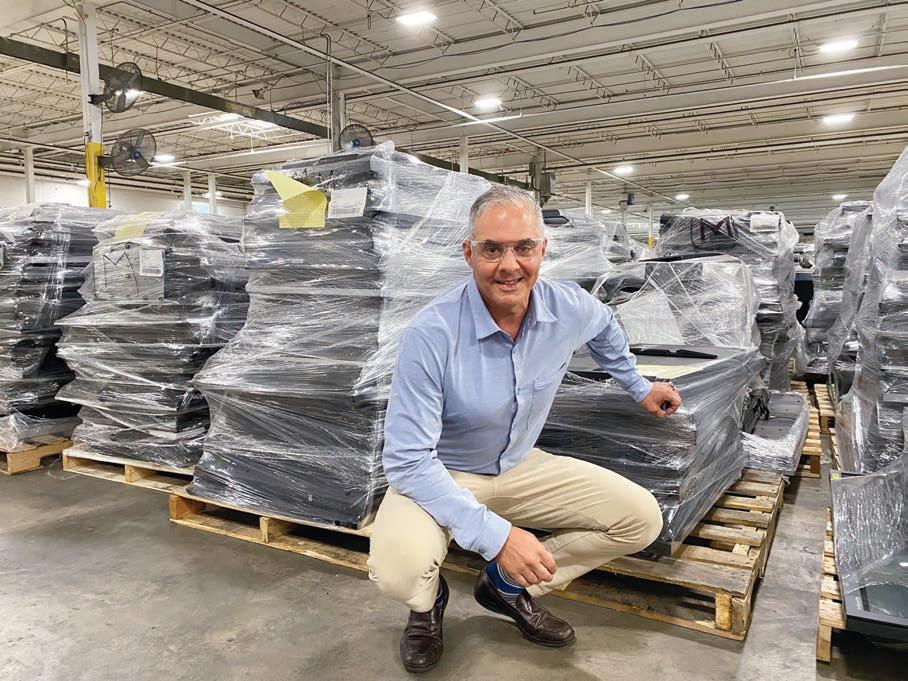
“If you chart it, you see it track the explosion of the personal computer and then the introduction of the cellphone,” Levine said. “ e volume has just gone through the roof.” e roof, and maybe even some clouds. Just the number of cellphones Regency processes is impressive.
“We process well over 100,000 cellphones a month,” Levine said.
And that’s just a small part of his business, in more ways than one. Cellphones are among the smaller items that ll much of Regency’s 600,000-square-foot facility on Darrow Road near the Stow-Hudson border.
e facility used to be a plant for the adhesives company Mactac, but Regency purchased it and moved its headquarters there in 2019. Levine said Regency occupies about 500,000 square feet there and subleases the rest.
Regency became part of Reserve Management Group, which recycles steel and other materials, via a merger in 2006, and Levine is a co-owner of Regency because of that deal, he said.
Still privately held, Regency doesn’t disclose its revenues or net income, but Levine said it has been pro table since a couple of years after it opened and has remained so ever since.
He’s got some other mile markers for Regency’s growth he will disclose, though.
“It’s a little tricky in our industry,” Levine said. “We measure our business in a couple of di erent ways — there are pieces and there are pounds. Years ago, the pounds were actually greater, because the pieces weighed more — think, an old projector or cathode ray TV. … But as the devices have gotten lighter, the number of devices has increased exponentially.”
Today Regency processes more than 100 million pounds of electronic waste annually, and well over 1 million pieces of equipment,
Levine said. e half-pound cellphones are combined with stu like hospital equipment that can weigh 100 pounds to make those totals.
e recycling doesn’t all happen in Stow. Regency has grown from eight people and a single location in Solon, where it started, to eight locations around the country with approximately 800 employees, Levine said. But with its massive footprint and about 300 employees, including a headquarters o ce sta of about 70, Stow is the company’s largest operation.
e goal of the business is twofold, Levine said. It’s a for-pro t business that needs to remain profitable to survive, he said.
“We’ve always felt that recycling at its core is as much about economics as it is about anything else,” Levine said.
But beyond making money, Regency’s bigger mission is to keep as much waste out of land lls as possi-
ble and to see to it that as many electronic components are reused as possible. Levine said with more than a hit of pride that 90% of the material that comes through the door is recycled or reused.
To do that requires a lot of work. Each piece that goes through a Regency facility is rst disassembled, often by hand on busy production lines.
ings that might be reusable, such as solid-state hard drives or RAM memory boards, are wiped clean, tested and certi ed for reuse whenever possible, Levine said. e company has industry-standard security protocols in place to ensure that data is kept con dential and thoroughly removed from any recycled equipment.
e work ranges from the relatively dirty job of removing screws and taking apart computer boxes and other devices by hand and doing the initial sorting, to work done by technicians to save particularly valuable and sensitive parts in dustfree clean rooms.
At the end of the process, what’s left, things like PC boards and other components, are shredded into ne pieces and run through a machine where magnets remove any ferrous metals. en the boards and other items, which are plastic, are recycled.
Levine knows his plant like the back of his hand, and his people seemingly as well. He gives a brisk tour of the plant at a pace that requires some e ort to keep up, saying hello to employees by name as he travels the circuit. It keeps him in shape.
“I never have trouble getting my steps in,” Levine said.
But Levine wants more places to walk, and, in the case of Regency and its facilities, eight is apparently not enough. Regency will soon expand with new facilities, beginning
Colorado that it is pursuing.
But he doesn’t plan to stop there.
“We’ve got our eyes on international expansion, I would say within the next 12 months,” Levine said.
at will entail opening a facility to serve the Middle Eastern and African markets, he said.
e company can fund the expansion without raising capital, like it has done with its previous facilities, by reinvesting its pro ts back into the business, Levine said.
ere’s no shortage of new electronics being turned out continually, which means that demand for recycling will only increase, said Levine, who likened the growth of electronic recycling to Moore’s Law, which dictates that integrated circuits double in capacity about every two years.
at law has held true since it originated in the 1970s, and it means that electronics not only become better, but also become obsolete very quickly, Levine said.
And the impact of the work Regency is doing is not small.
at’s according to the U.S. EPA, which pleads with consumers and businesses alike to send their used electronics to a recycler and not a land ll.

in the Mountain West region of the U.S., Levine said.
“We have plans before the end of this year to open an operation in Colorado,” he said. “It might be smaller than our traditional operation, but we’ll focus on smaller equipment, like cellphones and tablets.”
He declined to say where that facility will be located but said Regency has identi ed a couple of potential sites in
Recycling a million laptops saves the energy equivalent to the electricity used by more than 3,500 U.S. homes in a year, the EPA reports.
Recycling a million cellphones — less than a year’s work for Regency — saves 35,000 pounds of copper, 772 pounds of silver, 75 pounds of gold and 33 pounds of palladium, the EPA reports.
Dan Shingler: dshingler@crain.com, (216) 771-5290
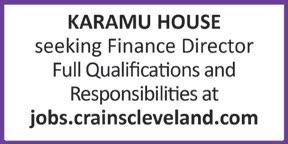

PEOPLE ON THE MOVE
To place your listing, visit www.crainscleveland.com/people-on-the-move or, for more information, contact Debora Stein at 917.226.5470 / dstein@crain.com
BANKING
West eld Bank

West eld Bank announces the promotion of Matthew Kilway to commercial loan of cer supporting investment advisors in the wealth and nancial planning sectors. In this role, Kilway will leverage over 11 years of experience in the nancial industry, combining expertise in both wealth planning and banking to provide custom nancial solutions for wealth management and investment planning rms. Kilway received a Bachelor of Science in Business Administration from the University of Akron.
FINANCIAL SERVICES
Ancora
Ancora is happy to announce that Joy M. Toman has joined the rm as an Assistant Vice President of Client Operations. Joy will assist the operations and sales teams with administrative needs while providing support to clients. Joy has previously held various sales management and operations roles with numerous retailers after beginning her professional career in 2002 with Dots, LLC. Joy earned an Associate of Applied Science degree in Graphic Design from the Rochester Institute of Technology.
FINANCIAL SERVICES
Brown Gibbons Lang & Company

Kira M. Sandmann has been promoted to Chief Marketing Of cer of Brown Gibbons Lang & Company, a leading independent investment bank and nancial advisory rm. Kira joined the rm in 2019 as Vice President of Marketing and has played a key role in advancing the rm’s brand and the continued growth of the organization. Prior to BGL, she served as the head of marketing for two Cleveland-area law rms. Kira earned her MBA from Kent State University and her B.A. from The Ohio State University.
HOSPITALITY & TOURISM
Kimpton Scho eld

The Kimpton Scho eld is pleased to announce Gia Polo as General Manager, bringing more than 18 years of hotel and hospitality experience. Her background includes serving as general manager for Stonebridge Companies in Washington, D.C.; corporate task force general manager for Interstate Hotels & Resorts; general manager for Interstate Hotels & Resorts in Washington; and managerial positions in suburban Washington and Greater Cleveland.



Renner Otto
The Intellectual Property Law Firm of Renner Otto is excited to announce the promotions of Kathryn J. Imeli & Lauren K. Tagarao to Senior Associate Attorney.
Kathryn Imeli has been with Renner Otto since 2015. Kathryn will continue to focus her practice on all aspects of patent prosecution and maintenance, counseling clients in protecting their innovation in a wide variety of technologies, including chemical, biomedical, mechanical, & computer arts.



CONSTRUCTION
Ohio Cat
Ohio Cat announces the promotion of Rob Cox to Vice President of Sales & Rental. Rob joined Ohio Cat in 2003 as a Compact Construction Sales Representative and was promoted in 2005 to manage compact equipment sales for Southern Ohio. In 2006, he became General Rental Manager and has since overseen all Heavy Equipment Rental functions of the business. Rob will now have responsibility for all Sales, Rental, and Marketing functions for Ohio Cat, Ohio Cat – The Cat Rental Store, and SITECH Ohio.


FINANCIAL SERVICES
Ancora
Ancora is happy to announce that Maura Lenherr has joined the rm as an Executive Administrative Assistant. Maura will greet and direct guests, facilitate deliveries and route incoming calls while acting as the general of ce manager. Prior to Ancora, Maura held various event services roles at Devil’s Thumb Ranch, Alderwood Colorado Management and most recently at Highway West Vacations in Colorado. Maura earned a Bachelor of Science degree in Hospitality Management from Niagara University.
FINANCIAL SERVICES
CM Wealth Advisors
CM Wealth Advisors is proud to announce the promotion of Paul A. Bodnar to Chief Investment Of cer. He will manage and oversee the rm’s investment strategy while continuing to work with our clients. Paul was central to evolving our private market strategy and developing our private co-investment program. Prior to joining CM in 2015, he was a senior equity research analyst.






HEALTH CARE
Richman LAW
KJK proudly announces the addition of Partner Michael D. Hoenig to the rm’s Litigation & Arbitration and Cyber Security & Data Breach practice groups. With a successful track record spanning over a decade, Michael excels in diverse industries, handling breach of contract, commercial tort, securities fraud, consumer protection and employment disputes. Additionally, KJK welcomes Senior Counsel Stephen D. Richman to the rm’s Real Estate practice group. With over three decades of experience, Stephen adeptly manages transactions involving retail, of ce, industrial and residential properties. His focus includes drafting and negotiating leases, purchase agreements, ancillary real estate documents and resolving landlord-tenant disputes.
Lauren Tagarao joined the rm in 2018. Lauren focuses on trademark law, using practical approaches to counsel clients in making informed decisions regarding the use, application, & enforcement of their brand assets and assisting with their management of domestic & foreign trademark portfolios.

LAW
Thrasher Dinsmore and Dolan
CONSTRUCTION
Ohio Cat
Ohio Cat is pleased to appoint Joe Coleman Vice President of Product Support. Joe joined the company in 1989 and has held several positions including Technician, Supervisor, Service Manager, and most recently General Product Support Manager. He will continue overseeing all aspects of Product Support, and his focus will be to maintain alignment with Caterpillar’s Services Growth and Operational Excellence Plans. Rob and Joe will work together to co-lead Ohio Cat into the future.
HEALTH CARE
The MetroHealth System
The MetroHealth System



Blinkhorn
The MetroHealth Foundation welcomes two new Ex Of cio members to the Board of Directors – Dr. Richard J. Blinkhorn Jr. and Alan K. Nevel. Dr. Blinkhorn is MetroHealth’s Executive Vice President, Chief Physician Executive & Clinical Of cer. He oversees the medical staff, advanced practice providers, department chairs, research programs, medical education, designated service lines, and clinical institutes for MetroHealth.
Nevel, Metrohealth’s Senior Vice President and Chief Equity and Impact Of cer, is responsible for de ning the overarching vision, identity and strategy at MetroHealth to eliminate systemic disparities and inequities that impact patients, employees and the community.


Nevel
The MetroHealth Foundation has elected Dr. Terry Stancin and Deandra Williams-Lewis to its Board of Directors. Dr. Stancin retired in 2022 as MetroHealth’s Chief of Psychology and Director of Child and Adolescent Psychiatry and Psychology. She was honored with the National Compassionate Caregiver of the Year award from the Schwartz Center for Compassionate Healthcare.
Christopher Holecek joined TDD as a partner in the Business Law, Civil Litigation and Labor & Employment practice groups. Chris has extensive trial experience in product liability, commercial disputes, trade secrets, and catastrophic personal injury. He also focuses on alternative dispute resolution, serving as an arbitrator and mediator for private litigants and the EEOC. Tanja Holecek joined TDD as a partner in the Family Law practice area. Tanja focuses her practice on divorce, dissolution, child/spousal support, parenting time, premarital agreements, and post-decree modi cation. She serves clients across all of Northeastern Ohio, both in litigated matters and in alternative resolution processes, such as the collaborative law process.
Stancin
MANUFACTURING
Oatey Co.
MANUFACTURING
Reese Pharmaceutical

Reese Pharmaceutical is proud to announce Daren Wischmeier as Purchasing Manager.




WilliamsLewis
Williams-Lewis is the Director, Ethics and Compliance for FirstEnergy Corp. She joined the company in 2021 after six years at ReliabilityFirst, overseeing the Human Resources, Finance and IT departments to lead crossfunctional and organization-wide initiatives. She serves on the Board of Directors for the Diversity Center of Northeast Ohio.

Oatey Co., a leading manufacturer in the plumbing industry, announced that Mickey McMillan has joined the organization as Vice President, Corporate Controller. With extensive experience in executivelevel nancial management, McMillan is a seasoned operational and strategic leader across all nancial disciplines. He will use his wide range of expertise to lead Oatey’s U.S. and global accounting operations, helping position Oatey for continued growth.
Daren’s responsibilities involve packaging and raw material ordering and managing suppliers. His background includes serving as a Buyer for Oatey Company, Senior Buyer/Planner at Applied Medical Technology, and he is pursuing his MBA in Operations and Supply Chain Planning. Reese Pharmaceutical is a family company located in downtown Cleveland, employing over 60 team members.

crainscleveland.com
Publisher and CEO KC Crain
Group publisher Jim Kirk (312) 397-5503 or jkirk@crain.com
Executive editor Elizabeth McIntyre (216) 771-5358 or emcintyre@crain.com
Associate publisher Amy Ann Stoessel (216) 771-5155 or astoessel@crain.com
Director of audience and engagement Elizabeth Couch, (313) 446-0419 or elizabeth.couch@crain.com
Managing editor Scott Suttell (216) 771-5227 or ssuttell@crain.com
Assistant managing editor John Kappes (216) 771-5359 or john.kappes@crain.com
Web editor Damon Sims (216) 771-5279 or dpsims@crain.com
Assistant editor Rachel Abbey McCa erty (216) 771-5379 or rmcca erty@crain.com
Art director Kayla Byler (614) 312-7635 or kayla.byler@crain.com
Cartoonist Rich Williams
REPORTERS
Stan Bullard, senior reporter, Real estate/construction (216) 771-5228 or sbullard@crain.com
Michelle Jarboe, Enterprise reporter (216) 771-5437 or michelle.jarboe@crain.com
Jay Miller Government (216) 771-5362 or jmiller@crain.com
Jeremy Nobile, Finance/legal/beer/cannabis (216) 771-5255 or jnobile@crain.com
Kim Palmer Government (216) 771-5384 or kpalmer@crain.com
Joe Scalzo, Sports business (216) 771-5256 or joe.scalzo@crain.com
Dan Shingler, Energy/steel/auto/Akron (216) 771-5290 or dshingler@crain.com
ADVERTISING
Senior vice president of sales Susan Jacobs (312) 649-5492 or susan.jacobs@crain.com
Events manager Missy Chambless (216) 771-5388 or missy.chambless@crain.com
Sales manager Mara Broderick (917) 612-8414 or mara.broderick@crain.com
Sales and marketing coordinator Shannon Smith (440) 281-6397 or shannon.smith@crain.com
Account executive
Kaylie Moran, Ed Sivillo
People on the Move manager
Debora Stein, (917) 226-5470, dstein@crain.com
Pre-press and digital production Craig L. Mackey
O ce coordinator Karen Friedman
Media services manager Nicole Spell
Billing YahNica Crawford
Credit Thomas Hanovich
CUSTOMER SERVICE
Customer service and subscriptions: (877) 824-9373 or customerservice@crainscleveland.com
Reprints: Laura Picariello (732) 723-0569 or lpicariello@crain.com
Crain’s Cleveland Business is published by Crain Communications Inc.
Chairman Keith E. Crain
Vice chairman Mary Kay Crain
President and CEO KC Crain
Senior executive VP Chris Crain
Chief Financial O cer Robert Recchia G.D. Crain Jr. Founder (1885-1973)
Mrs. G.D. Crain Jr. Chairman (1911-1996)
Editorial & Business O ces 700 W. St. Clair Ave., Suite 310, Cleveland, OH 44113-1230 (216) 522-1383
Volume 44, Number 26
Crain’s Cleveland Business (ISSN 0197-2375) is published weekly, except no issue on 1/2, 5/29, 7/10, 9/4 and 11/27, at 700 West St. Clair Ave., Suite 310, Cleveland, OH 44113-1230.
Cleveland Business, 1155 Gratiot Avenue, Detroit, MI, 48207-9911, or email to customerservice@crainscleveland.com, or call (877) 824-9373 (in the U.S. and Canada) or (313) 446-0450 (all other locations), or fax (313) 446-6777.
